Organisation Behaviour Unit: 12
VerifiedAdded on 2021/01/01
|21
|7744
|266
AI Summary
Contribute Materials
Your contribution can guide someone’s learning journey. Share your
documents today.

ORGANISATION
BEHAVIOUR
UNIT: 12
BEHAVIOUR
UNIT: 12
Secure Best Marks with AI Grader
Need help grading? Try our AI Grader for instant feedback on your assignments.
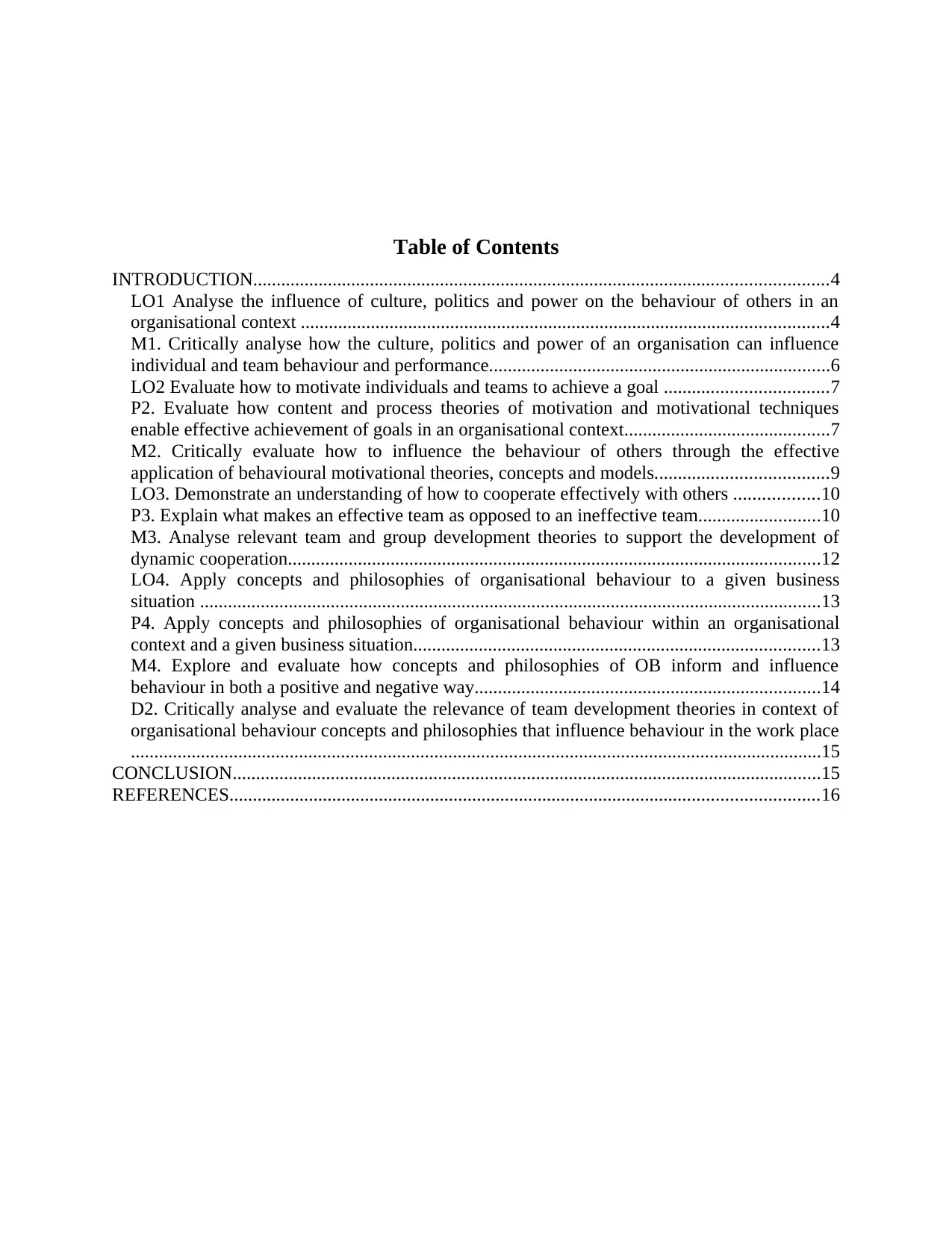
Table of Contents
INTRODUCTION...........................................................................................................................4
LO1 Analyse the influence of culture, politics and power on the behaviour of others in an
organisational context .................................................................................................................4
M1. Critically analyse how the culture, politics and power of an organisation can influence
individual and team behaviour and performance.........................................................................6
LO2 Evaluate how to motivate individuals and teams to achieve a goal ...................................7
P2. Evaluate how content and process theories of motivation and motivational techniques
enable effective achievement of goals in an organisational context............................................7
M2. Critically evaluate how to influence the behaviour of others through the effective
application of behavioural motivational theories, concepts and models.....................................9
LO3. Demonstrate an understanding of how to cooperate effectively with others ..................10
P3. Explain what makes an effective team as opposed to an ineffective team..........................10
M3. Analyse relevant team and group development theories to support the development of
dynamic cooperation..................................................................................................................12
LO4. Apply concepts and philosophies of organisational behaviour to a given business
situation .....................................................................................................................................13
P4. Apply concepts and philosophies of organisational behaviour within an organisational
context and a given business situation.......................................................................................13
M4. Explore and evaluate how concepts and philosophies of OB inform and influence
behaviour in both a positive and negative way..........................................................................14
D2. Critically analyse and evaluate the relevance of team development theories in context of
organisational behaviour concepts and philosophies that influence behaviour in the work place
....................................................................................................................................................15
CONCLUSION..............................................................................................................................15
REFERENCES..............................................................................................................................16
INTRODUCTION...........................................................................................................................4
LO1 Analyse the influence of culture, politics and power on the behaviour of others in an
organisational context .................................................................................................................4
M1. Critically analyse how the culture, politics and power of an organisation can influence
individual and team behaviour and performance.........................................................................6
LO2 Evaluate how to motivate individuals and teams to achieve a goal ...................................7
P2. Evaluate how content and process theories of motivation and motivational techniques
enable effective achievement of goals in an organisational context............................................7
M2. Critically evaluate how to influence the behaviour of others through the effective
application of behavioural motivational theories, concepts and models.....................................9
LO3. Demonstrate an understanding of how to cooperate effectively with others ..................10
P3. Explain what makes an effective team as opposed to an ineffective team..........................10
M3. Analyse relevant team and group development theories to support the development of
dynamic cooperation..................................................................................................................12
LO4. Apply concepts and philosophies of organisational behaviour to a given business
situation .....................................................................................................................................13
P4. Apply concepts and philosophies of organisational behaviour within an organisational
context and a given business situation.......................................................................................13
M4. Explore and evaluate how concepts and philosophies of OB inform and influence
behaviour in both a positive and negative way..........................................................................14
D2. Critically analyse and evaluate the relevance of team development theories in context of
organisational behaviour concepts and philosophies that influence behaviour in the work place
....................................................................................................................................................15
CONCLUSION..............................................................................................................................15
REFERENCES..............................................................................................................................16
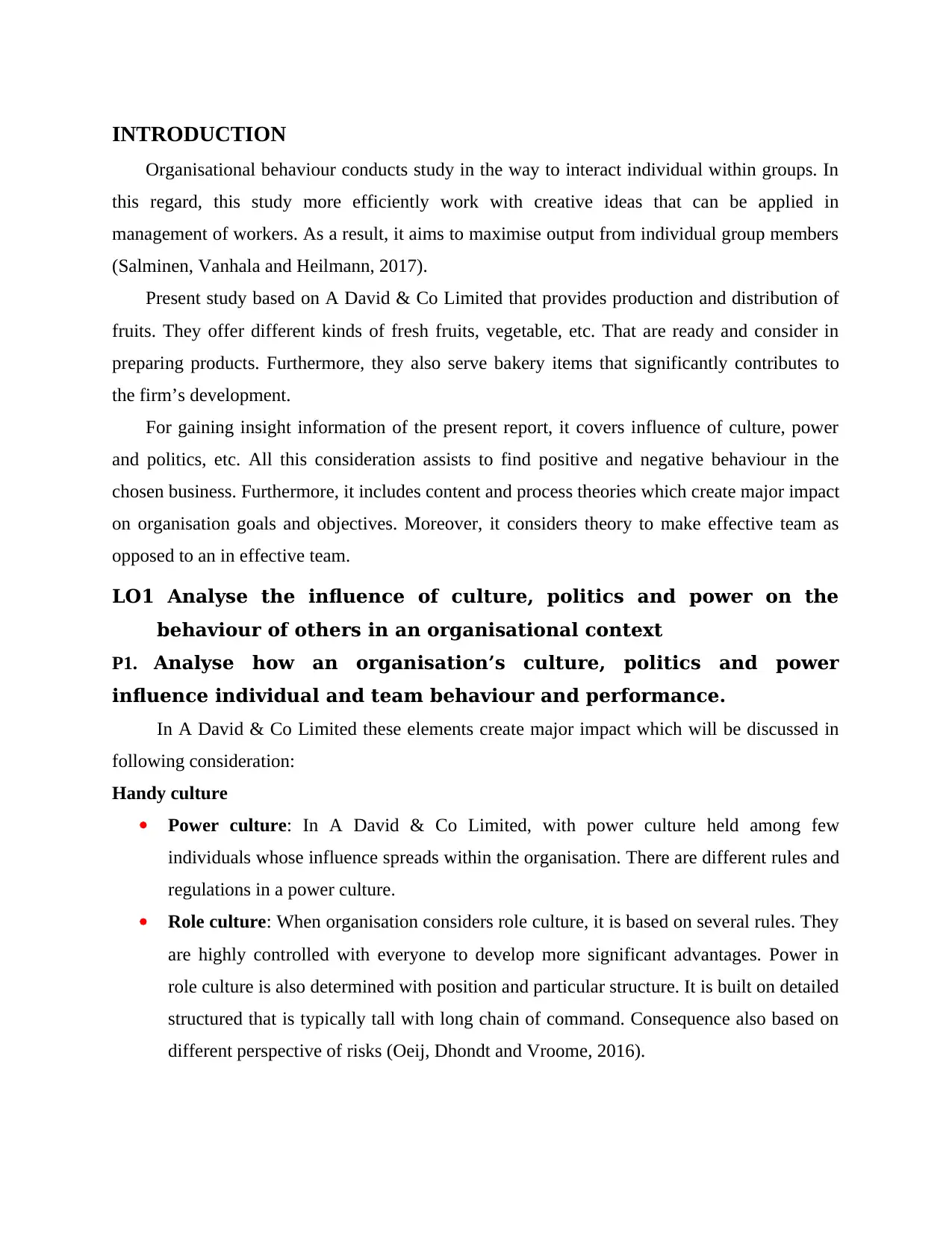
INTRODUCTION
Organisational behaviour conducts study in the way to interact individual within groups. In
this regard, this study more efficiently work with creative ideas that can be applied in
management of workers. As a result, it aims to maximise output from individual group members
(Salminen, Vanhala and Heilmann, 2017).
Present study based on A David & Co Limited that provides production and distribution of
fruits. They offer different kinds of fresh fruits, vegetable, etc. That are ready and consider in
preparing products. Furthermore, they also serve bakery items that significantly contributes to
the firm’s development.
For gaining insight information of the present report, it covers influence of culture, power
and politics, etc. All this consideration assists to find positive and negative behaviour in the
chosen business. Furthermore, it includes content and process theories which create major impact
on organisation goals and objectives. Moreover, it considers theory to make effective team as
opposed to an in effective team.
LO1 Analyse the influence of culture, politics and power on the
behaviour of others in an organisational context
P1. Analyse how an organisation’s culture, politics and power
influence individual and team behaviour and performance.
In A David & Co Limited these elements create major impact which will be discussed in
following consideration:
Handy culture
Power culture: In A David & Co Limited, with power culture held among few
individuals whose influence spreads within the organisation. There are different rules and
regulations in a power culture.
Role culture: When organisation considers role culture, it is based on several rules. They
are highly controlled with everyone to develop more significant advantages. Power in
role culture is also determined with position and particular structure. It is built on detailed
structured that is typically tall with long chain of command. Consequence also based on
different perspective of risks (Oeij, Dhondt and Vroome, 2016).
Organisational behaviour conducts study in the way to interact individual within groups. In
this regard, this study more efficiently work with creative ideas that can be applied in
management of workers. As a result, it aims to maximise output from individual group members
(Salminen, Vanhala and Heilmann, 2017).
Present study based on A David & Co Limited that provides production and distribution of
fruits. They offer different kinds of fresh fruits, vegetable, etc. That are ready and consider in
preparing products. Furthermore, they also serve bakery items that significantly contributes to
the firm’s development.
For gaining insight information of the present report, it covers influence of culture, power
and politics, etc. All this consideration assists to find positive and negative behaviour in the
chosen business. Furthermore, it includes content and process theories which create major impact
on organisation goals and objectives. Moreover, it considers theory to make effective team as
opposed to an in effective team.
LO1 Analyse the influence of culture, politics and power on the
behaviour of others in an organisational context
P1. Analyse how an organisation’s culture, politics and power
influence individual and team behaviour and performance.
In A David & Co Limited these elements create major impact which will be discussed in
following consideration:
Handy culture
Power culture: In A David & Co Limited, with power culture held among few
individuals whose influence spreads within the organisation. There are different rules and
regulations in a power culture.
Role culture: When organisation considers role culture, it is based on several rules. They
are highly controlled with everyone to develop more significant advantages. Power in
role culture is also determined with position and particular structure. It is built on detailed
structured that is typically tall with long chain of command. Consequence also based on
different perspective of risks (Oeij, Dhondt and Vroome, 2016).
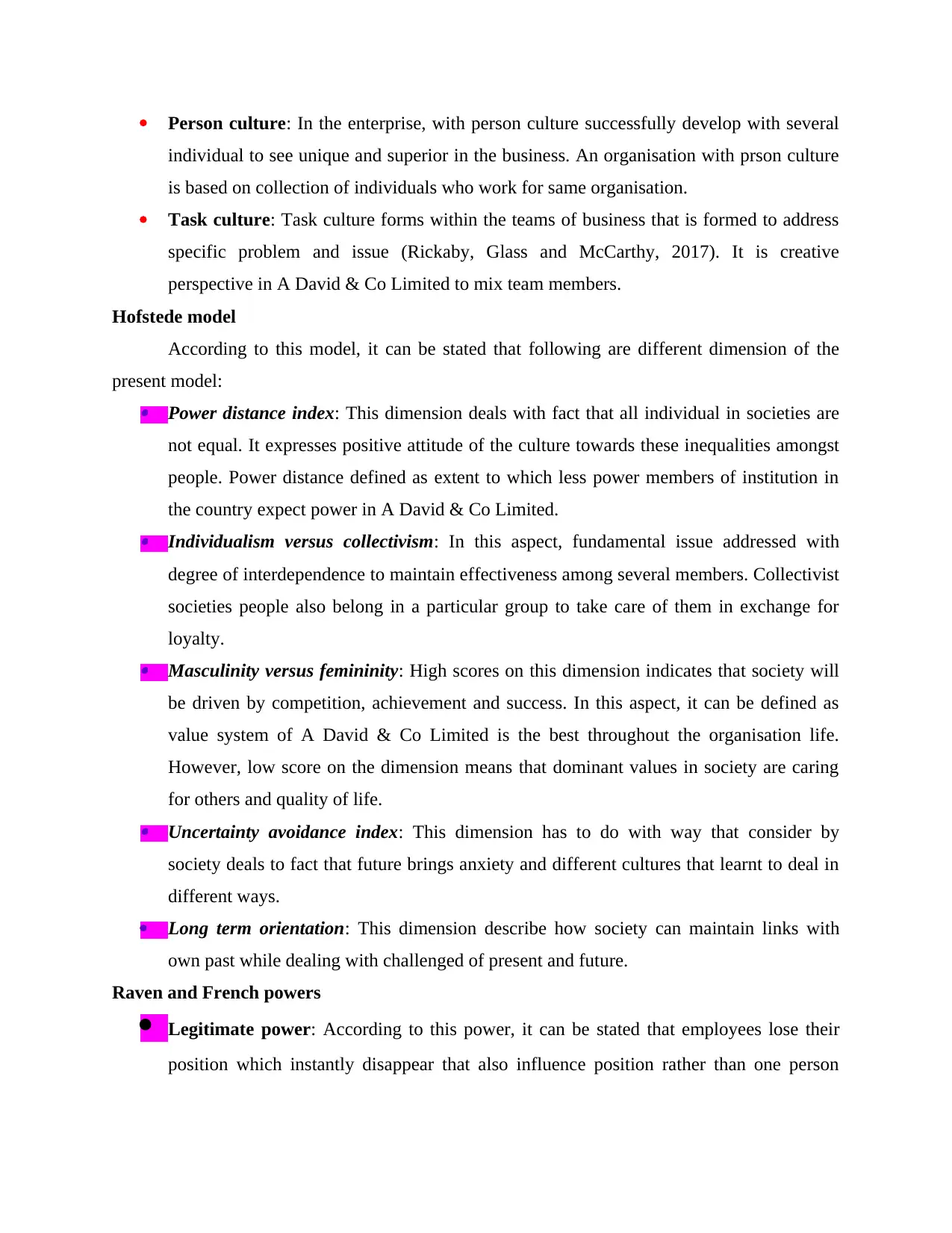
Person culture: In the enterprise, with person culture successfully develop with several
individual to see unique and superior in the business. An organisation with prson culture
is based on collection of individuals who work for same organisation.
Task culture: Task culture forms within the teams of business that is formed to address
specific problem and issue (Rickaby, Glass and McCarthy, 2017). It is creative
perspective in A David & Co Limited to mix team members.
Hofstede model
According to this model, it can be stated that following are different dimension of the
present model: Power distance index: This dimension deals with fact that all individual in societies are
not equal. It expresses positive attitude of the culture towards these inequalities amongst
people. Power distance defined as extent to which less power members of institution in
the country expect power in A David & Co Limited. Individualism versus collectivism: In this aspect, fundamental issue addressed with
degree of interdependence to maintain effectiveness among several members. Collectivist
societies people also belong in a particular group to take care of them in exchange for
loyalty. Masculinity versus femininity: High scores on this dimension indicates that society will
be driven by competition, achievement and success. In this aspect, it can be defined as
value system of A David & Co Limited is the best throughout the organisation life.
However, low score on the dimension means that dominant values in society are caring
for others and quality of life. Uncertainty avoidance index: This dimension has to do with way that consider by
society deals to fact that future brings anxiety and different cultures that learnt to deal in
different ways.
Long term orientation: This dimension describe how society can maintain links with
own past while dealing with challenged of present and future.
Raven and French powers
Legitimate power: According to this power, it can be stated that employees lose their
position which instantly disappear that also influence position rather than one person
individual to see unique and superior in the business. An organisation with prson culture
is based on collection of individuals who work for same organisation.
Task culture: Task culture forms within the teams of business that is formed to address
specific problem and issue (Rickaby, Glass and McCarthy, 2017). It is creative
perspective in A David & Co Limited to mix team members.
Hofstede model
According to this model, it can be stated that following are different dimension of the
present model: Power distance index: This dimension deals with fact that all individual in societies are
not equal. It expresses positive attitude of the culture towards these inequalities amongst
people. Power distance defined as extent to which less power members of institution in
the country expect power in A David & Co Limited. Individualism versus collectivism: In this aspect, fundamental issue addressed with
degree of interdependence to maintain effectiveness among several members. Collectivist
societies people also belong in a particular group to take care of them in exchange for
loyalty. Masculinity versus femininity: High scores on this dimension indicates that society will
be driven by competition, achievement and success. In this aspect, it can be defined as
value system of A David & Co Limited is the best throughout the organisation life.
However, low score on the dimension means that dominant values in society are caring
for others and quality of life. Uncertainty avoidance index: This dimension has to do with way that consider by
society deals to fact that future brings anxiety and different cultures that learnt to deal in
different ways.
Long term orientation: This dimension describe how society can maintain links with
own past while dealing with challenged of present and future.
Raven and French powers
Legitimate power: According to this power, it can be stated that employees lose their
position which instantly disappear that also influence position rather than one person
Secure Best Marks with AI Grader
Need help grading? Try our AI Grader for instant feedback on your assignments.
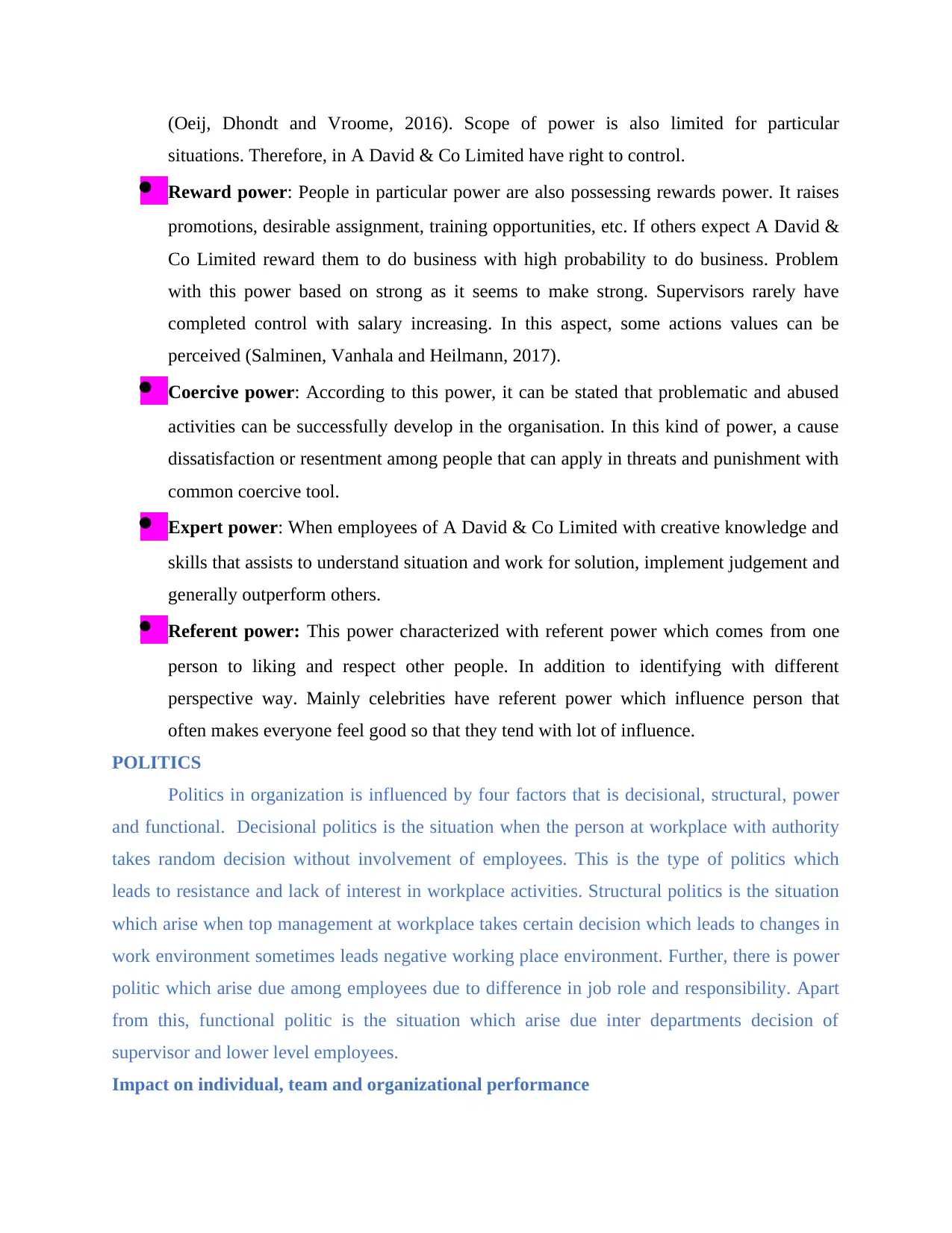
(Oeij, Dhondt and Vroome, 2016). Scope of power is also limited for particular
situations. Therefore, in A David & Co Limited have right to control.
Reward power: People in particular power are also possessing rewards power. It raises
promotions, desirable assignment, training opportunities, etc. If others expect A David &
Co Limited reward them to do business with high probability to do business. Problem
with this power based on strong as it seems to make strong. Supervisors rarely have
completed control with salary increasing. In this aspect, some actions values can be
perceived (Salminen, Vanhala and Heilmann, 2017).
Coercive power: According to this power, it can be stated that problematic and abused
activities can be successfully develop in the organisation. In this kind of power, a cause
dissatisfaction or resentment among people that can apply in threats and punishment with
common coercive tool.
Expert power: When employees of A David & Co Limited with creative knowledge and
skills that assists to understand situation and work for solution, implement judgement and
generally outperform others.
Referent power: This power characterized with referent power which comes from one
person to liking and respect other people. In addition to identifying with different
perspective way. Mainly celebrities have referent power which influence person that
often makes everyone feel good so that they tend with lot of influence.
POLITICS
Politics in organization is influenced by four factors that is decisional, structural, power
and functional. Decisional politics is the situation when the person at workplace with authority
takes random decision without involvement of employees. This is the type of politics which
leads to resistance and lack of interest in workplace activities. Structural politics is the situation
which arise when top management at workplace takes certain decision which leads to changes in
work environment sometimes leads negative working place environment. Further, there is power
politic which arise due among employees due to difference in job role and responsibility. Apart
from this, functional politic is the situation which arise due inter departments decision of
supervisor and lower level employees.
Impact on individual, team and organizational performance
situations. Therefore, in A David & Co Limited have right to control.
Reward power: People in particular power are also possessing rewards power. It raises
promotions, desirable assignment, training opportunities, etc. If others expect A David &
Co Limited reward them to do business with high probability to do business. Problem
with this power based on strong as it seems to make strong. Supervisors rarely have
completed control with salary increasing. In this aspect, some actions values can be
perceived (Salminen, Vanhala and Heilmann, 2017).
Coercive power: According to this power, it can be stated that problematic and abused
activities can be successfully develop in the organisation. In this kind of power, a cause
dissatisfaction or resentment among people that can apply in threats and punishment with
common coercive tool.
Expert power: When employees of A David & Co Limited with creative knowledge and
skills that assists to understand situation and work for solution, implement judgement and
generally outperform others.
Referent power: This power characterized with referent power which comes from one
person to liking and respect other people. In addition to identifying with different
perspective way. Mainly celebrities have referent power which influence person that
often makes everyone feel good so that they tend with lot of influence.
POLITICS
Politics in organization is influenced by four factors that is decisional, structural, power
and functional. Decisional politics is the situation when the person at workplace with authority
takes random decision without involvement of employees. This is the type of politics which
leads to resistance and lack of interest in workplace activities. Structural politics is the situation
which arise when top management at workplace takes certain decision which leads to changes in
work environment sometimes leads negative working place environment. Further, there is power
politic which arise due among employees due to difference in job role and responsibility. Apart
from this, functional politic is the situation which arise due inter departments decision of
supervisor and lower level employees.
Impact on individual, team and organizational performance

Power, politics and culture are significant beliefs in the study of organisation behaviour.
With this regard, power and politics are lively conceptions and are important functions of
communication between several elements in A David & Co Limited. On organisation behaviour
of the chosen business, power influence positively which influence and control anything which
helps to value others.
A David and Co. Ltd is influenced by power culture where employees work in
pressurized environment which impacts performance and interest of employees and team
coordination.
The influence of politics on A David and Co. Ltd is of sudden decisions which hampers
employees and team performance. This is also denoted by hofstede's cultural dimension
according to people of UK are resistance to uncertain conditions and situation at work place.
Expert power impact employees, team and organisational performance of David A co.
Ltd. Where expert individuals of organization are focused on managing employee’s motivation
and creative workplace environment by boost interest of employees and team working which
enhance organisational performance.
M1. Critically analyse how the culture, politics and power of an
organisation can influence individual and team behaviour and
performance.
In order to determine successful power, it can be stated that culture, power and politics
influence to the individual and team performances. For example, when manager of A David &
Co Limited get reward power it impacts positive with performing desired level of results. On the
other hand, when manager not getting reward power, they are not effectively involved to make
appropriate decisions in the business. Hence, it impacts negative on the results. Power, politics
and culture related with each other because it contain individual and team performances in
effective manner. For instance, when manager follow task culture they need to work within the
team to distribute it among several members. As a result, it assists to focus on the special quality
of employees to perform several functions and operations as per the business requirements.
Culture can be defining as the arts and other manifestation of human intellectual achievement
regarded collectively. Power can be define as ability or capacity to do something. Capacity and
ability also influence the behaviour of others or course of event. With use of coercive power,
people can deal with threaten that someone will be fired. Position also allows taking justification
With this regard, power and politics are lively conceptions and are important functions of
communication between several elements in A David & Co Limited. On organisation behaviour
of the chosen business, power influence positively which influence and control anything which
helps to value others.
A David and Co. Ltd is influenced by power culture where employees work in
pressurized environment which impacts performance and interest of employees and team
coordination.
The influence of politics on A David and Co. Ltd is of sudden decisions which hampers
employees and team performance. This is also denoted by hofstede's cultural dimension
according to people of UK are resistance to uncertain conditions and situation at work place.
Expert power impact employees, team and organisational performance of David A co.
Ltd. Where expert individuals of organization are focused on managing employee’s motivation
and creative workplace environment by boost interest of employees and team working which
enhance organisational performance.
M1. Critically analyse how the culture, politics and power of an
organisation can influence individual and team behaviour and
performance.
In order to determine successful power, it can be stated that culture, power and politics
influence to the individual and team performances. For example, when manager of A David &
Co Limited get reward power it impacts positive with performing desired level of results. On the
other hand, when manager not getting reward power, they are not effectively involved to make
appropriate decisions in the business. Hence, it impacts negative on the results. Power, politics
and culture related with each other because it contain individual and team performances in
effective manner. For instance, when manager follow task culture they need to work within the
team to distribute it among several members. As a result, it assists to focus on the special quality
of employees to perform several functions and operations as per the business requirements.
Culture can be defining as the arts and other manifestation of human intellectual achievement
regarded collectively. Power can be define as ability or capacity to do something. Capacity and
ability also influence the behaviour of others or course of event. With use of coercive power,
people can deal with threaten that someone will be fired. Position also allows taking justification

to do several things (Rickaby, Glass and McCarthy, 2017). Power decides generally judged
which can be accomplishing to perform functions to make quick decisions. It also assists to
develop long term interest of the chosen business (Webb, Morgan and Goddard, 2016). People
will listen to employees to maintain trust and respect that stated by people. With the help, ideas
that possess by other that look to develop leadership in particular area (Bittencourt, Meeuwisse
and Fonseca, 2016).
LO2 Evaluate how to motivate individuals and teams to achieve a
goal
P2. Evaluate how content and process theories of motivation and
motivational techniques enable effective achievement of goals in
an organisational context
Generally, there are two kinds of theories of motivations, which are content and process
theories. The content theories refer to fulfil staff members needs in appropriate manner.
Therefore, they can motivate employees with suing different sources. On the other hand, the
process theory refers to ways to motivate employees. Some motivational theories have been
discussed below. Also, how the use of the theory can contribute in developing motivational
techniques in an organisation has been evaluated.
Maslow’s theory of motivation: In this theory hierarchy of needs is considered in different rang
from lower to higher. Lower needs of employees fulfilled leading to demand other needs. In A
David & Co Limited, this kind of needs consider limitations and criticism. There is little
limitation which considers evidence support to follow hierarchical strictly. Research has
challenged to impose Maslow’s pyramids. Social needs are mainly higher than any others
(Webb, Morgan and Goddard, 2016). Maslow's theory helps in the chosen business to fulfil staff
members needs with providing them several benefits. This is because, each staff member of A
David & Co Limited has different needs and requirement. Therefore, manager need to deal as per
their requirements.
Table 1. hierarchy of needs theory
Needs Implementation
Physiological
needs
It includes food, shelter, clothing, etc. To manage this need Maslow can
provide pantry facility to employees. This will help the firm in managing
which can be accomplishing to perform functions to make quick decisions. It also assists to
develop long term interest of the chosen business (Webb, Morgan and Goddard, 2016). People
will listen to employees to maintain trust and respect that stated by people. With the help, ideas
that possess by other that look to develop leadership in particular area (Bittencourt, Meeuwisse
and Fonseca, 2016).
LO2 Evaluate how to motivate individuals and teams to achieve a
goal
P2. Evaluate how content and process theories of motivation and
motivational techniques enable effective achievement of goals in
an organisational context
Generally, there are two kinds of theories of motivations, which are content and process
theories. The content theories refer to fulfil staff members needs in appropriate manner.
Therefore, they can motivate employees with suing different sources. On the other hand, the
process theory refers to ways to motivate employees. Some motivational theories have been
discussed below. Also, how the use of the theory can contribute in developing motivational
techniques in an organisation has been evaluated.
Maslow’s theory of motivation: In this theory hierarchy of needs is considered in different rang
from lower to higher. Lower needs of employees fulfilled leading to demand other needs. In A
David & Co Limited, this kind of needs consider limitations and criticism. There is little
limitation which considers evidence support to follow hierarchical strictly. Research has
challenged to impose Maslow’s pyramids. Social needs are mainly higher than any others
(Webb, Morgan and Goddard, 2016). Maslow's theory helps in the chosen business to fulfil staff
members needs with providing them several benefits. This is because, each staff member of A
David & Co Limited has different needs and requirement. Therefore, manager need to deal as per
their requirements.
Table 1. hierarchy of needs theory
Needs Implementation
Physiological
needs
It includes food, shelter, clothing, etc. To manage this need Maslow can
provide pantry facility to employees. This will help the firm in managing
Paraphrase This Document
Need a fresh take? Get an instant paraphrase of this document with our AI Paraphraser
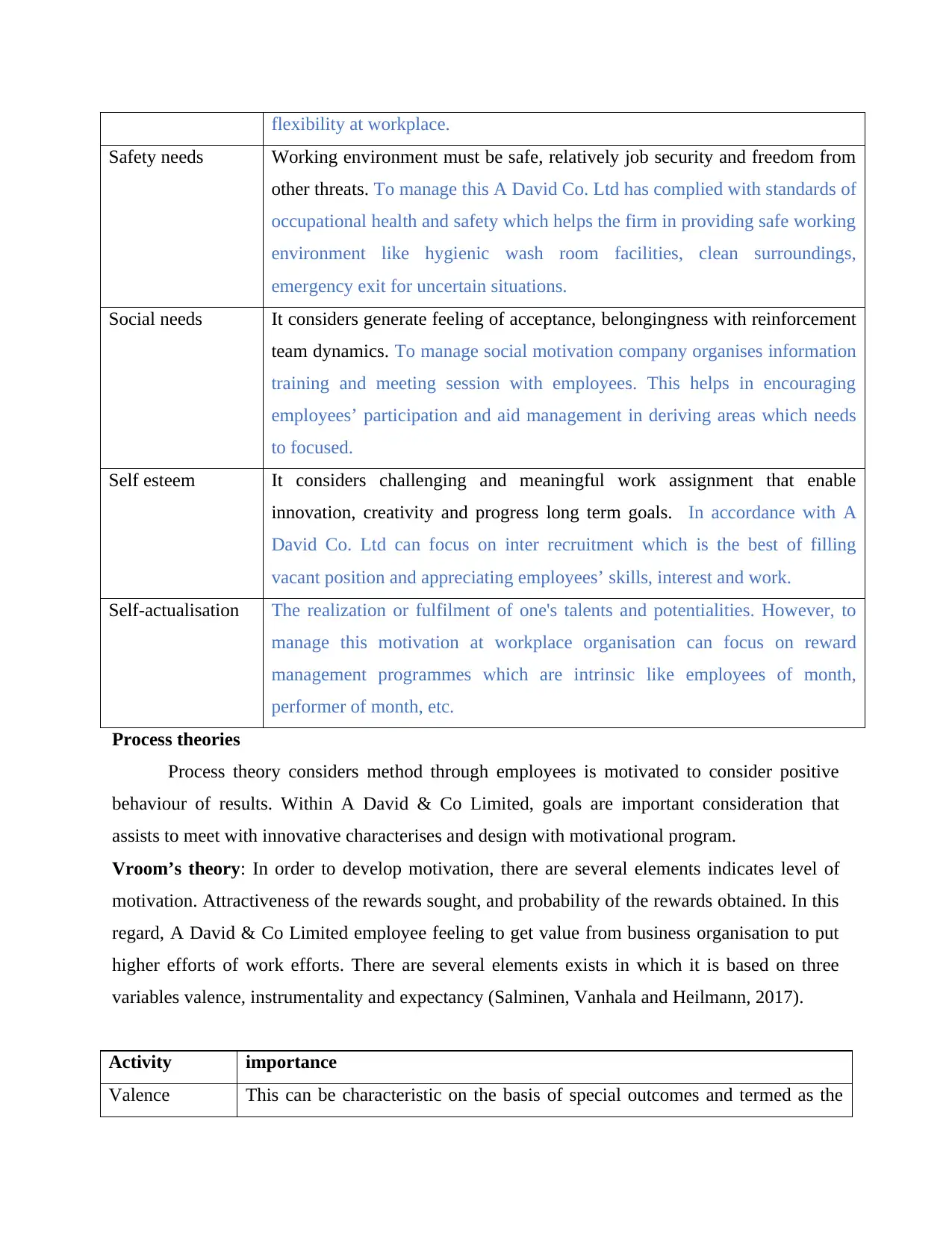
flexibility at workplace.
Safety needs Working environment must be safe, relatively job security and freedom from
other threats. To manage this A David Co. Ltd has complied with standards of
occupational health and safety which helps the firm in providing safe working
environment like hygienic wash room facilities, clean surroundings,
emergency exit for uncertain situations.
Social needs It considers generate feeling of acceptance, belongingness with reinforcement
team dynamics. To manage social motivation company organises information
training and meeting session with employees. This helps in encouraging
employees’ participation and aid management in deriving areas which needs
to focused.
Self esteem It considers challenging and meaningful work assignment that enable
innovation, creativity and progress long term goals. In accordance with A
David Co. Ltd can focus on inter recruitment which is the best of filling
vacant position and appreciating employees’ skills, interest and work.
Self-actualisation The realization or fulfilment of one's talents and potentialities. However, to
manage this motivation at workplace organisation can focus on reward
management programmes which are intrinsic like employees of month,
performer of month, etc.
Process theories
Process theory considers method through employees is motivated to consider positive
behaviour of results. Within A David & Co Limited, goals are important consideration that
assists to meet with innovative characterises and design with motivational program.
Vroom’s theory: In order to develop motivation, there are several elements indicates level of
motivation. Attractiveness of the rewards sought, and probability of the rewards obtained. In this
regard, A David & Co Limited employee feeling to get value from business organisation to put
higher efforts of work efforts. There are several elements exists in which it is based on three
variables valence, instrumentality and expectancy (Salminen, Vanhala and Heilmann, 2017).
Activity importance
Valence This can be characteristic on the basis of special outcomes and termed as the
Safety needs Working environment must be safe, relatively job security and freedom from
other threats. To manage this A David Co. Ltd has complied with standards of
occupational health and safety which helps the firm in providing safe working
environment like hygienic wash room facilities, clean surroundings,
emergency exit for uncertain situations.
Social needs It considers generate feeling of acceptance, belongingness with reinforcement
team dynamics. To manage social motivation company organises information
training and meeting session with employees. This helps in encouraging
employees’ participation and aid management in deriving areas which needs
to focused.
Self esteem It considers challenging and meaningful work assignment that enable
innovation, creativity and progress long term goals. In accordance with A
David Co. Ltd can focus on inter recruitment which is the best of filling
vacant position and appreciating employees’ skills, interest and work.
Self-actualisation The realization or fulfilment of one's talents and potentialities. However, to
manage this motivation at workplace organisation can focus on reward
management programmes which are intrinsic like employees of month,
performer of month, etc.
Process theories
Process theory considers method through employees is motivated to consider positive
behaviour of results. Within A David & Co Limited, goals are important consideration that
assists to meet with innovative characterises and design with motivational program.
Vroom’s theory: In order to develop motivation, there are several elements indicates level of
motivation. Attractiveness of the rewards sought, and probability of the rewards obtained. In this
regard, A David & Co Limited employee feeling to get value from business organisation to put
higher efforts of work efforts. There are several elements exists in which it is based on three
variables valence, instrumentality and expectancy (Salminen, Vanhala and Heilmann, 2017).
Activity importance
Valence This can be characteristic on the basis of special outcomes and termed as the

valence. As a result, people can prefer different activist behaviour.
Instrumentality In this regard, association between first level and second level also ascertained
to gain positive results.
Expectancy It considers relationship, between chosen course of action and its predicted
outcomes.
As per Vroom theory, manager of the chosen organisation need to indicate certain levels
of motivation through they can easily communicate several benefits to get best value. In this
regard, more efforts and efficiency required among several employees to deal with desired level
of outcomes. In addition to this, it can be recommended that action must be taken to focus on the
predicted outcomes and results. This type of motivation in A David Co. Ltd can be managed by
management by offering extra part for extra work. This will increase employee interest in work
and also will helps in achieving business objectives.
Thus, in accordance with content and process theory of motivation it can be said that
fulfilling hierarchical needs of motivation like self-actualisation and social and physiological
needs of employee can assist A David & Co Limited in boosting employee’s morale.
M2. Critically evaluate how to influence the behaviour of others
through the effective application of behavioural motivational
theories, concepts and models.
There are different kinds of content and process theories applied such as Maslow’s and
Vroom theory. In the content theory, main focus of A David & Co Limited to motivate staff
members through fulfil needs of them as per requirements. This considers understanding towards
that develops research. It gives answer of what to motivate staff members with different sources
(Peso, Even and Barron, 2014). With this regard, Maslow’s theory considers different kinds of
elements of needs. For instance, physiological needs, safety needs, social needs, self -esteem
self-actualisation. These needs must be satisfied by the chosen enterprise to deal with creative
activities and tasks. Therefore, hierarchical structure of needs followed by manager to deal with
each person requirement. In addition to this, it is also useful to focus on effective application of
motivation in the business. When manager fulfil each level of need, it helps to increases loyalty
of staff members towards the business. On the other hand, vroom theory also considers
developing more effective results at workplace. Valence, instrumentality and expectancy are
Instrumentality In this regard, association between first level and second level also ascertained
to gain positive results.
Expectancy It considers relationship, between chosen course of action and its predicted
outcomes.
As per Vroom theory, manager of the chosen organisation need to indicate certain levels
of motivation through they can easily communicate several benefits to get best value. In this
regard, more efforts and efficiency required among several employees to deal with desired level
of outcomes. In addition to this, it can be recommended that action must be taken to focus on the
predicted outcomes and results. This type of motivation in A David Co. Ltd can be managed by
management by offering extra part for extra work. This will increase employee interest in work
and also will helps in achieving business objectives.
Thus, in accordance with content and process theory of motivation it can be said that
fulfilling hierarchical needs of motivation like self-actualisation and social and physiological
needs of employee can assist A David & Co Limited in boosting employee’s morale.
M2. Critically evaluate how to influence the behaviour of others
through the effective application of behavioural motivational
theories, concepts and models.
There are different kinds of content and process theories applied such as Maslow’s and
Vroom theory. In the content theory, main focus of A David & Co Limited to motivate staff
members through fulfil needs of them as per requirements. This considers understanding towards
that develops research. It gives answer of what to motivate staff members with different sources
(Peso, Even and Barron, 2014). With this regard, Maslow’s theory considers different kinds of
elements of needs. For instance, physiological needs, safety needs, social needs, self -esteem
self-actualisation. These needs must be satisfied by the chosen enterprise to deal with creative
activities and tasks. Therefore, hierarchical structure of needs followed by manager to deal with
each person requirement. In addition to this, it is also useful to focus on effective application of
motivation in the business. When manager fulfil each level of need, it helps to increases loyalty
of staff members towards the business. On the other hand, vroom theory also considers
developing more effective results at workplace. Valence, instrumentality and expectancy are
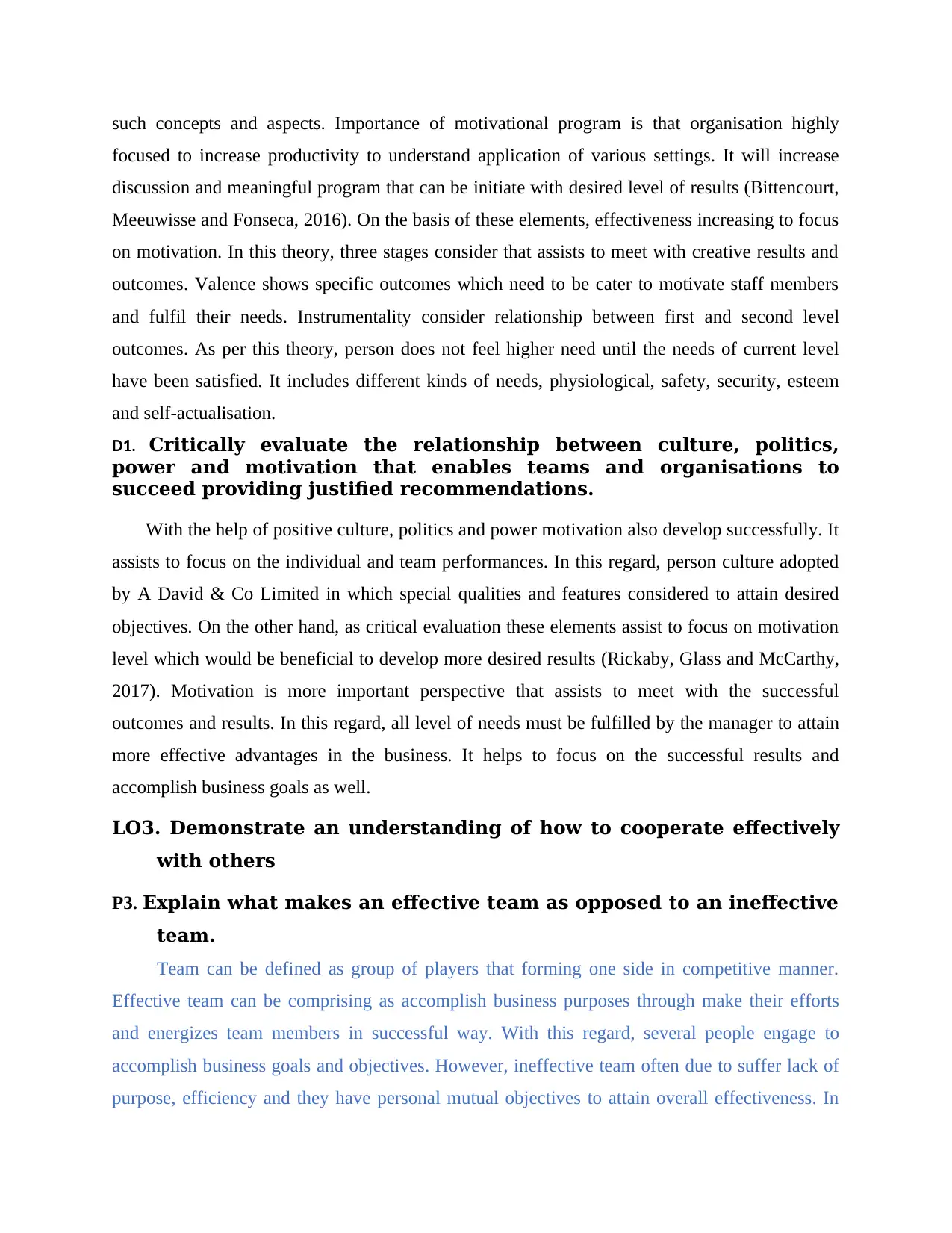
such concepts and aspects. Importance of motivational program is that organisation highly
focused to increase productivity to understand application of various settings. It will increase
discussion and meaningful program that can be initiate with desired level of results (Bittencourt,
Meeuwisse and Fonseca, 2016). On the basis of these elements, effectiveness increasing to focus
on motivation. In this theory, three stages consider that assists to meet with creative results and
outcomes. Valence shows specific outcomes which need to be cater to motivate staff members
and fulfil their needs. Instrumentality consider relationship between first and second level
outcomes. As per this theory, person does not feel higher need until the needs of current level
have been satisfied. It includes different kinds of needs, physiological, safety, security, esteem
and self-actualisation.
D1. Critically evaluate the relationship between culture, politics,
power and motivation that enables teams and organisations to
succeed providing justified recommendations.
With the help of positive culture, politics and power motivation also develop successfully. It
assists to focus on the individual and team performances. In this regard, person culture adopted
by A David & Co Limited in which special qualities and features considered to attain desired
objectives. On the other hand, as critical evaluation these elements assist to focus on motivation
level which would be beneficial to develop more desired results (Rickaby, Glass and McCarthy,
2017). Motivation is more important perspective that assists to meet with the successful
outcomes and results. In this regard, all level of needs must be fulfilled by the manager to attain
more effective advantages in the business. It helps to focus on the successful results and
accomplish business goals as well.
LO3. Demonstrate an understanding of how to cooperate effectively
with others
P3. Explain what makes an effective team as opposed to an ineffective
team.
Team can be defined as group of players that forming one side in competitive manner.
Effective team can be comprising as accomplish business purposes through make their efforts
and energizes team members in successful way. With this regard, several people engage to
accomplish business goals and objectives. However, ineffective team often due to suffer lack of
purpose, efficiency and they have personal mutual objectives to attain overall effectiveness. In
focused to increase productivity to understand application of various settings. It will increase
discussion and meaningful program that can be initiate with desired level of results (Bittencourt,
Meeuwisse and Fonseca, 2016). On the basis of these elements, effectiveness increasing to focus
on motivation. In this theory, three stages consider that assists to meet with creative results and
outcomes. Valence shows specific outcomes which need to be cater to motivate staff members
and fulfil their needs. Instrumentality consider relationship between first and second level
outcomes. As per this theory, person does not feel higher need until the needs of current level
have been satisfied. It includes different kinds of needs, physiological, safety, security, esteem
and self-actualisation.
D1. Critically evaluate the relationship between culture, politics,
power and motivation that enables teams and organisations to
succeed providing justified recommendations.
With the help of positive culture, politics and power motivation also develop successfully. It
assists to focus on the individual and team performances. In this regard, person culture adopted
by A David & Co Limited in which special qualities and features considered to attain desired
objectives. On the other hand, as critical evaluation these elements assist to focus on motivation
level which would be beneficial to develop more desired results (Rickaby, Glass and McCarthy,
2017). Motivation is more important perspective that assists to meet with the successful
outcomes and results. In this regard, all level of needs must be fulfilled by the manager to attain
more effective advantages in the business. It helps to focus on the successful results and
accomplish business goals as well.
LO3. Demonstrate an understanding of how to cooperate effectively
with others
P3. Explain what makes an effective team as opposed to an ineffective
team.
Team can be defined as group of players that forming one side in competitive manner.
Effective team can be comprising as accomplish business purposes through make their efforts
and energizes team members in successful way. With this regard, several people engage to
accomplish business goals and objectives. However, ineffective team often due to suffer lack of
purpose, efficiency and they have personal mutual objectives to attain overall effectiveness. In
Secure Best Marks with AI Grader
Need help grading? Try our AI Grader for instant feedback on your assignments.
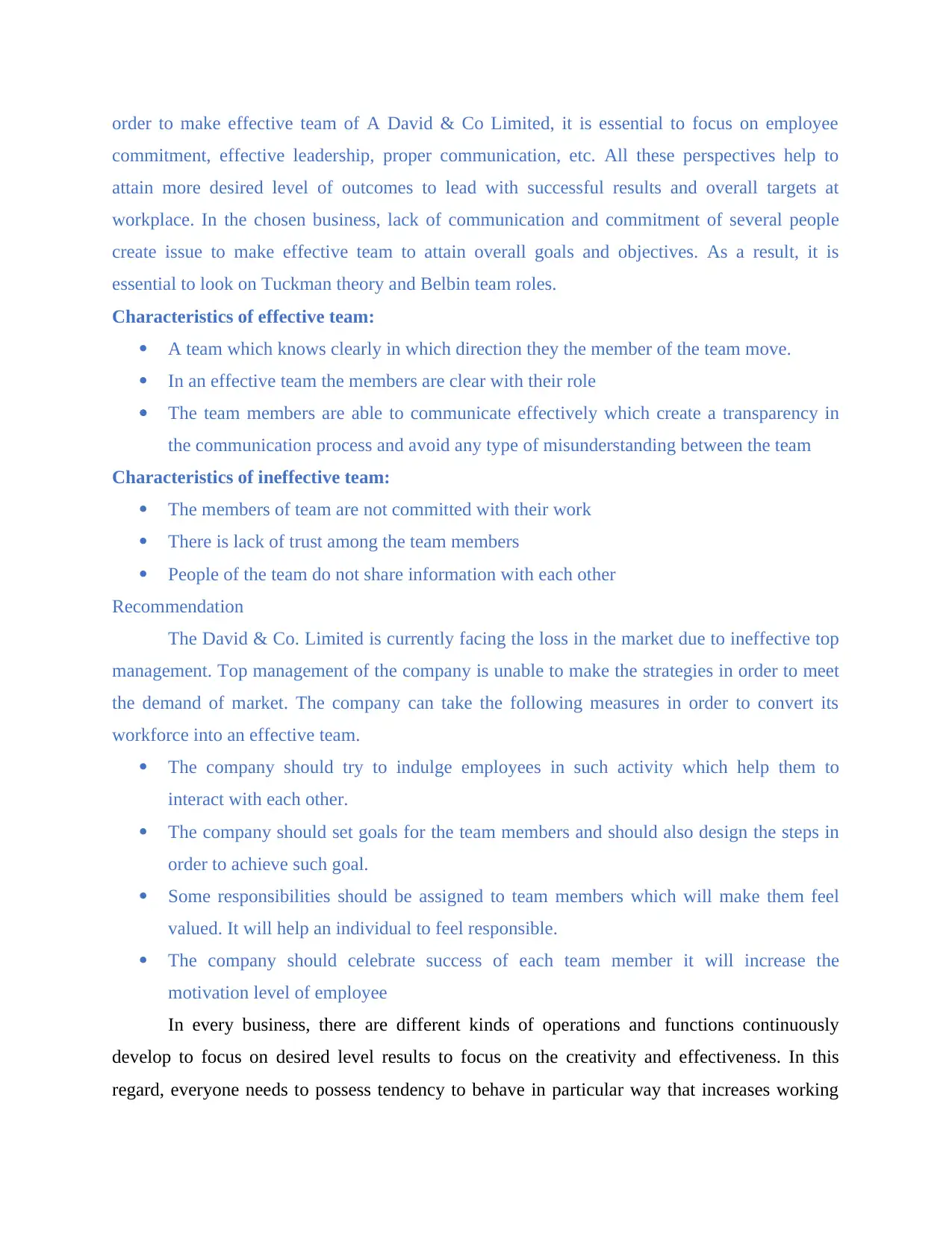
order to make effective team of A David & Co Limited, it is essential to focus on employee
commitment, effective leadership, proper communication, etc. All these perspectives help to
attain more desired level of outcomes to lead with successful results and overall targets at
workplace. In the chosen business, lack of communication and commitment of several people
create issue to make effective team to attain overall goals and objectives. As a result, it is
essential to look on Tuckman theory and Belbin team roles.
Characteristics of effective team:
A team which knows clearly in which direction they the member of the team move.
In an effective team the members are clear with their role
The team members are able to communicate effectively which create a transparency in
the communication process and avoid any type of misunderstanding between the team
Characteristics of ineffective team:
The members of team are not committed with their work
There is lack of trust among the team members
People of the team do not share information with each other
Recommendation
The David & Co. Limited is currently facing the loss in the market due to ineffective top
management. Top management of the company is unable to make the strategies in order to meet
the demand of market. The company can take the following measures in order to convert its
workforce into an effective team.
The company should try to indulge employees in such activity which help them to
interact with each other.
The company should set goals for the team members and should also design the steps in
order to achieve such goal.
Some responsibilities should be assigned to team members which will make them feel
valued. It will help an individual to feel responsible.
The company should celebrate success of each team member it will increase the
motivation level of employee
In every business, there are different kinds of operations and functions continuously
develop to focus on desired level results to focus on the creativity and effectiveness. In this
regard, everyone needs to possess tendency to behave in particular way that increases working
commitment, effective leadership, proper communication, etc. All these perspectives help to
attain more desired level of outcomes to lead with successful results and overall targets at
workplace. In the chosen business, lack of communication and commitment of several people
create issue to make effective team to attain overall goals and objectives. As a result, it is
essential to look on Tuckman theory and Belbin team roles.
Characteristics of effective team:
A team which knows clearly in which direction they the member of the team move.
In an effective team the members are clear with their role
The team members are able to communicate effectively which create a transparency in
the communication process and avoid any type of misunderstanding between the team
Characteristics of ineffective team:
The members of team are not committed with their work
There is lack of trust among the team members
People of the team do not share information with each other
Recommendation
The David & Co. Limited is currently facing the loss in the market due to ineffective top
management. Top management of the company is unable to make the strategies in order to meet
the demand of market. The company can take the following measures in order to convert its
workforce into an effective team.
The company should try to indulge employees in such activity which help them to
interact with each other.
The company should set goals for the team members and should also design the steps in
order to achieve such goal.
Some responsibilities should be assigned to team members which will make them feel
valued. It will help an individual to feel responsible.
The company should celebrate success of each team member it will increase the
motivation level of employee
In every business, there are different kinds of operations and functions continuously
develop to focus on desired level results to focus on the creativity and effectiveness. In this
regard, everyone needs to possess tendency to behave in particular way that increases working
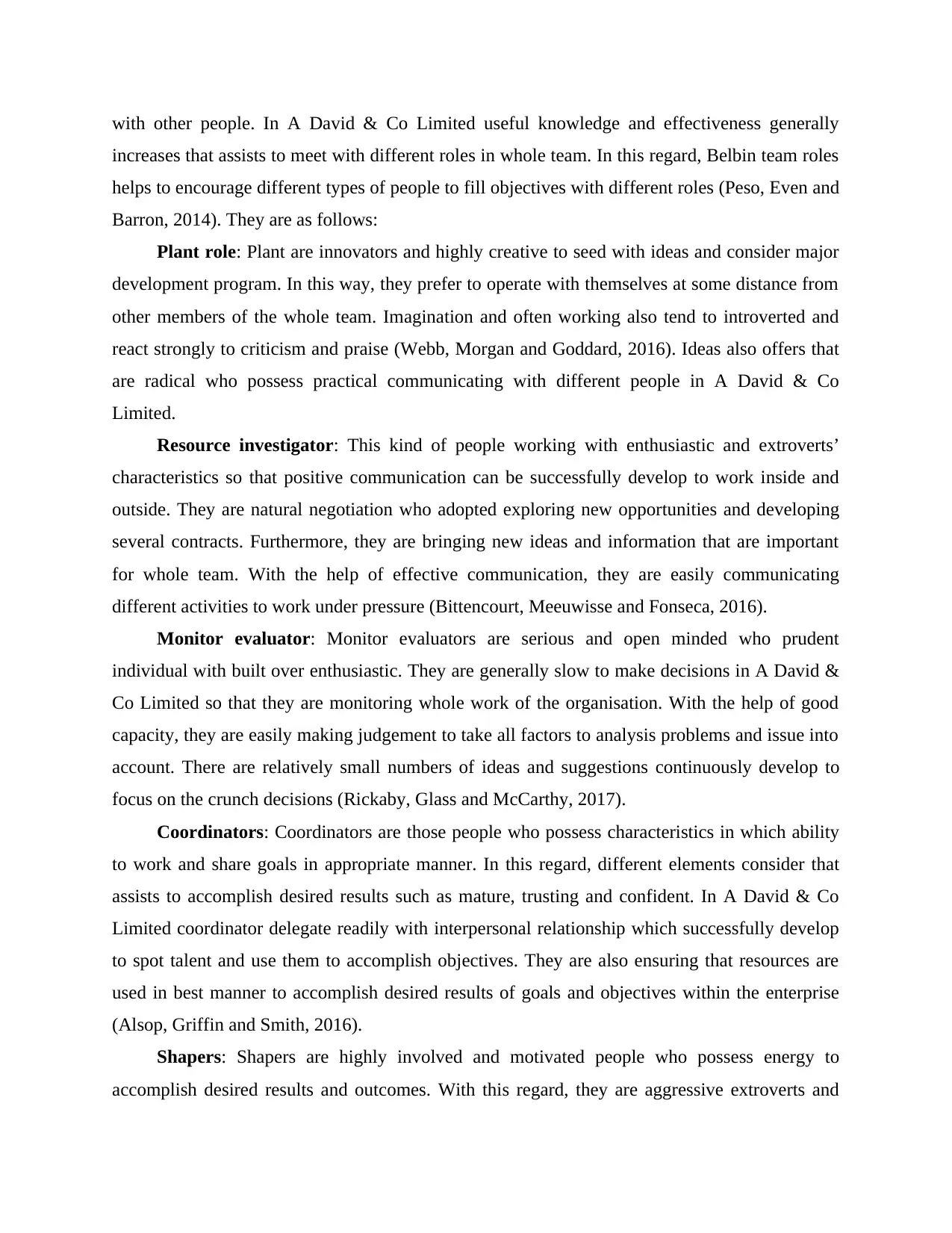
with other people. In A David & Co Limited useful knowledge and effectiveness generally
increases that assists to meet with different roles in whole team. In this regard, Belbin team roles
helps to encourage different types of people to fill objectives with different roles (Peso, Even and
Barron, 2014). They are as follows:
Plant role: Plant are innovators and highly creative to seed with ideas and consider major
development program. In this way, they prefer to operate with themselves at some distance from
other members of the whole team. Imagination and often working also tend to introverted and
react strongly to criticism and praise (Webb, Morgan and Goddard, 2016). Ideas also offers that
are radical who possess practical communicating with different people in A David & Co
Limited.
Resource investigator: This kind of people working with enthusiastic and extroverts’
characteristics so that positive communication can be successfully develop to work inside and
outside. They are natural negotiation who adopted exploring new opportunities and developing
several contracts. Furthermore, they are bringing new ideas and information that are important
for whole team. With the help of effective communication, they are easily communicating
different activities to work under pressure (Bittencourt, Meeuwisse and Fonseca, 2016).
Monitor evaluator: Monitor evaluators are serious and open minded who prudent
individual with built over enthusiastic. They are generally slow to make decisions in A David &
Co Limited so that they are monitoring whole work of the organisation. With the help of good
capacity, they are easily making judgement to take all factors to analysis problems and issue into
account. There are relatively small numbers of ideas and suggestions continuously develop to
focus on the crunch decisions (Rickaby, Glass and McCarthy, 2017).
Coordinators: Coordinators are those people who possess characteristics in which ability
to work and share goals in appropriate manner. In this regard, different elements consider that
assists to accomplish desired results such as mature, trusting and confident. In A David & Co
Limited coordinator delegate readily with interpersonal relationship which successfully develop
to spot talent and use them to accomplish objectives. They are also ensuring that resources are
used in best manner to accomplish desired results of goals and objectives within the enterprise
(Alsop, Griffin and Smith, 2016).
Shapers: Shapers are highly involved and motivated people who possess energy to
accomplish desired results and outcomes. With this regard, they are aggressive extroverts and
increases that assists to meet with different roles in whole team. In this regard, Belbin team roles
helps to encourage different types of people to fill objectives with different roles (Peso, Even and
Barron, 2014). They are as follows:
Plant role: Plant are innovators and highly creative to seed with ideas and consider major
development program. In this way, they prefer to operate with themselves at some distance from
other members of the whole team. Imagination and often working also tend to introverted and
react strongly to criticism and praise (Webb, Morgan and Goddard, 2016). Ideas also offers that
are radical who possess practical communicating with different people in A David & Co
Limited.
Resource investigator: This kind of people working with enthusiastic and extroverts’
characteristics so that positive communication can be successfully develop to work inside and
outside. They are natural negotiation who adopted exploring new opportunities and developing
several contracts. Furthermore, they are bringing new ideas and information that are important
for whole team. With the help of effective communication, they are easily communicating
different activities to work under pressure (Bittencourt, Meeuwisse and Fonseca, 2016).
Monitor evaluator: Monitor evaluators are serious and open minded who prudent
individual with built over enthusiastic. They are generally slow to make decisions in A David &
Co Limited so that they are monitoring whole work of the organisation. With the help of good
capacity, they are easily making judgement to take all factors to analysis problems and issue into
account. There are relatively small numbers of ideas and suggestions continuously develop to
focus on the crunch decisions (Rickaby, Glass and McCarthy, 2017).
Coordinators: Coordinators are those people who possess characteristics in which ability
to work and share goals in appropriate manner. In this regard, different elements consider that
assists to accomplish desired results such as mature, trusting and confident. In A David & Co
Limited coordinator delegate readily with interpersonal relationship which successfully develop
to spot talent and use them to accomplish objectives. They are also ensuring that resources are
used in best manner to accomplish desired results of goals and objectives within the enterprise
(Alsop, Griffin and Smith, 2016).
Shapers: Shapers are highly involved and motivated people who possess energy to
accomplish desired results and outcomes. With this regard, they are aggressive extroverts and
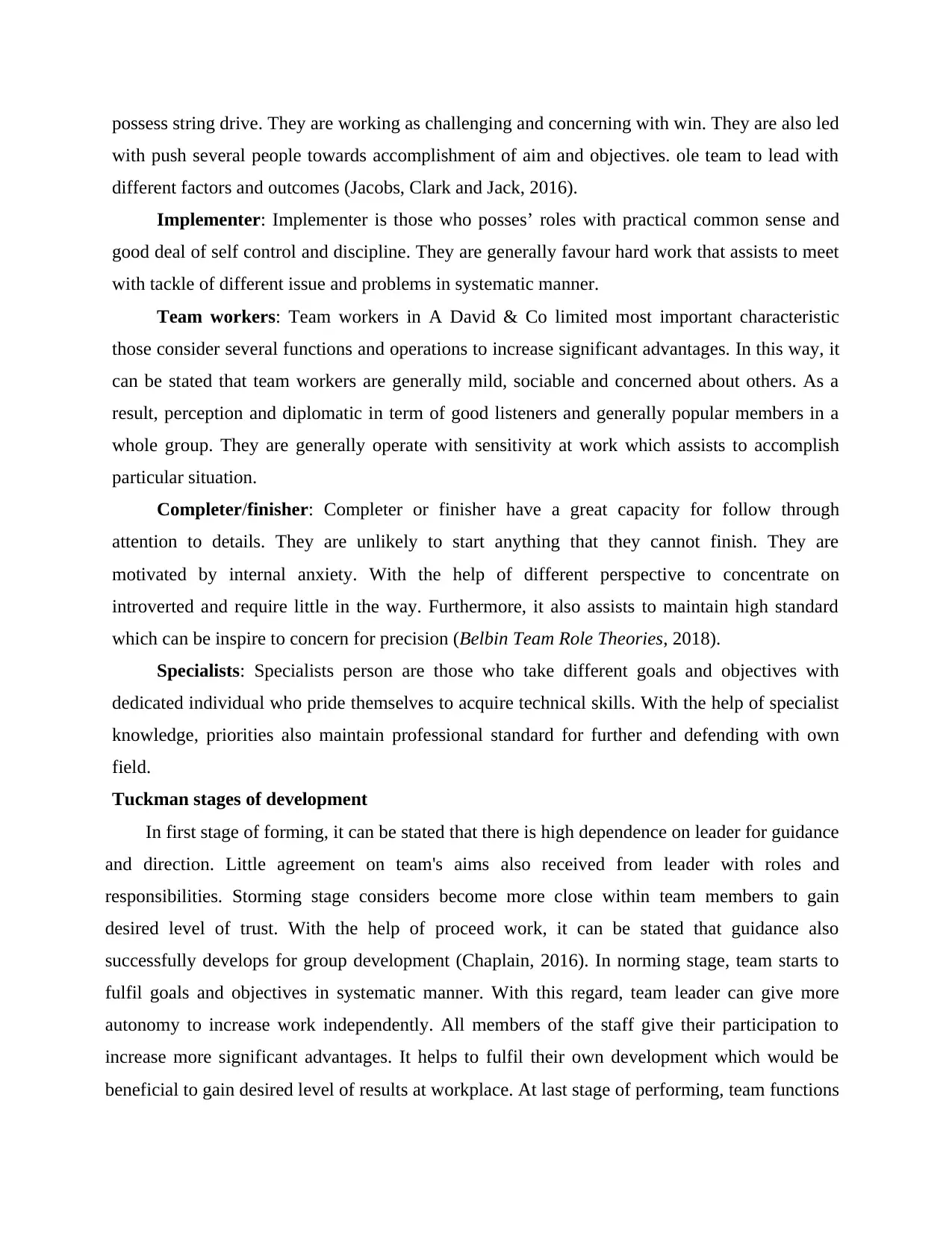
possess string drive. They are working as challenging and concerning with win. They are also led
with push several people towards accomplishment of aim and objectives. ole team to lead with
different factors and outcomes (Jacobs, Clark and Jack, 2016).
Implementer: Implementer is those who posses’ roles with practical common sense and
good deal of self control and discipline. They are generally favour hard work that assists to meet
with tackle of different issue and problems in systematic manner.
Team workers: Team workers in A David & Co limited most important characteristic
those consider several functions and operations to increase significant advantages. In this way, it
can be stated that team workers are generally mild, sociable and concerned about others. As a
result, perception and diplomatic in term of good listeners and generally popular members in a
whole group. They are generally operate with sensitivity at work which assists to accomplish
particular situation.
Completer/finisher: Completer or finisher have a great capacity for follow through
attention to details. They are unlikely to start anything that they cannot finish. They are
motivated by internal anxiety. With the help of different perspective to concentrate on
introverted and require little in the way. Furthermore, it also assists to maintain high standard
which can be inspire to concern for precision (Belbin Team Role Theories, 2018).
Specialists: Specialists person are those who take different goals and objectives with
dedicated individual who pride themselves to acquire technical skills. With the help of specialist
knowledge, priorities also maintain professional standard for further and defending with own
field.
Tuckman stages of development
In first stage of forming, it can be stated that there is high dependence on leader for guidance
and direction. Little agreement on team's aims also received from leader with roles and
responsibilities. Storming stage considers become more close within team members to gain
desired level of trust. With the help of proceed work, it can be stated that guidance also
successfully develops for group development (Chaplain, 2016). In norming stage, team starts to
fulfil goals and objectives in systematic manner. With this regard, team leader can give more
autonomy to increase work independently. All members of the staff give their participation to
increase more significant advantages. It helps to fulfil their own development which would be
beneficial to gain desired level of results at workplace. At last stage of performing, team functions
with push several people towards accomplishment of aim and objectives. ole team to lead with
different factors and outcomes (Jacobs, Clark and Jack, 2016).
Implementer: Implementer is those who posses’ roles with practical common sense and
good deal of self control and discipline. They are generally favour hard work that assists to meet
with tackle of different issue and problems in systematic manner.
Team workers: Team workers in A David & Co limited most important characteristic
those consider several functions and operations to increase significant advantages. In this way, it
can be stated that team workers are generally mild, sociable and concerned about others. As a
result, perception and diplomatic in term of good listeners and generally popular members in a
whole group. They are generally operate with sensitivity at work which assists to accomplish
particular situation.
Completer/finisher: Completer or finisher have a great capacity for follow through
attention to details. They are unlikely to start anything that they cannot finish. They are
motivated by internal anxiety. With the help of different perspective to concentrate on
introverted and require little in the way. Furthermore, it also assists to maintain high standard
which can be inspire to concern for precision (Belbin Team Role Theories, 2018).
Specialists: Specialists person are those who take different goals and objectives with
dedicated individual who pride themselves to acquire technical skills. With the help of specialist
knowledge, priorities also maintain professional standard for further and defending with own
field.
Tuckman stages of development
In first stage of forming, it can be stated that there is high dependence on leader for guidance
and direction. Little agreement on team's aims also received from leader with roles and
responsibilities. Storming stage considers become more close within team members to gain
desired level of trust. With the help of proceed work, it can be stated that guidance also
successfully develops for group development (Chaplain, 2016). In norming stage, team starts to
fulfil goals and objectives in systematic manner. With this regard, team leader can give more
autonomy to increase work independently. All members of the staff give their participation to
increase more significant advantages. It helps to fulfil their own development which would be
beneficial to gain desired level of results at workplace. At last stage of performing, team functions
Paraphrase This Document
Need a fresh take? Get an instant paraphrase of this document with our AI Paraphraser
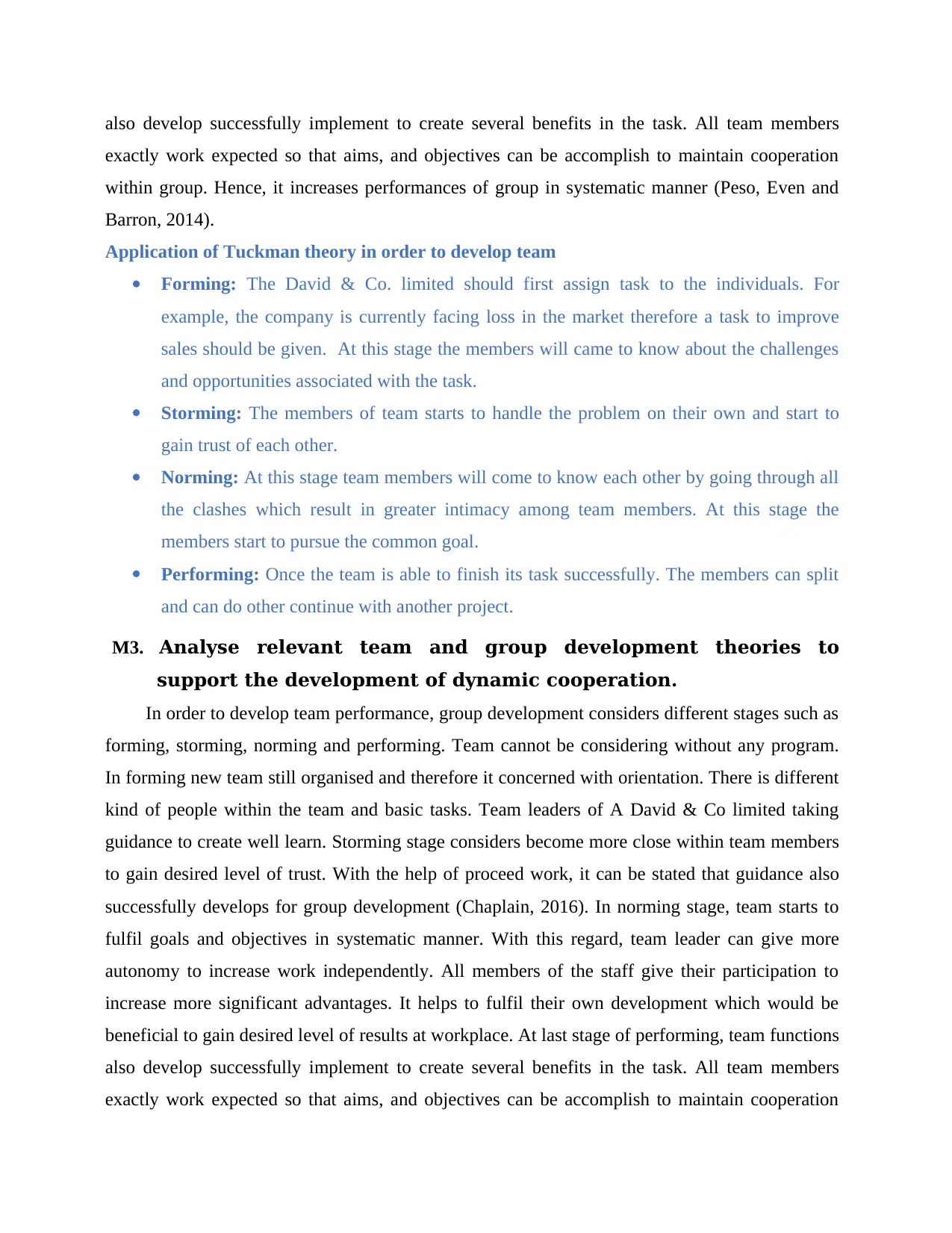
also develop successfully implement to create several benefits in the task. All team members
exactly work expected so that aims, and objectives can be accomplish to maintain cooperation
within group. Hence, it increases performances of group in systematic manner (Peso, Even and
Barron, 2014).
Application of Tuckman theory in order to develop team
Forming: The David & Co. limited should first assign task to the individuals. For
example, the company is currently facing loss in the market therefore a task to improve
sales should be given. At this stage the members will came to know about the challenges
and opportunities associated with the task.
Storming: The members of team starts to handle the problem on their own and start to
gain trust of each other.
Norming: At this stage team members will come to know each other by going through all
the clashes which result in greater intimacy among team members. At this stage the
members start to pursue the common goal.
Performing: Once the team is able to finish its task successfully. The members can split
and can do other continue with another project.
M3. Analyse relevant team and group development theories to
support the development of dynamic cooperation.
In order to develop team performance, group development considers different stages such as
forming, storming, norming and performing. Team cannot be considering without any program.
In forming new team still organised and therefore it concerned with orientation. There is different
kind of people within the team and basic tasks. Team leaders of A David & Co limited taking
guidance to create well learn. Storming stage considers become more close within team members
to gain desired level of trust. With the help of proceed work, it can be stated that guidance also
successfully develops for group development (Chaplain, 2016). In norming stage, team starts to
fulfil goals and objectives in systematic manner. With this regard, team leader can give more
autonomy to increase work independently. All members of the staff give their participation to
increase more significant advantages. It helps to fulfil their own development which would be
beneficial to gain desired level of results at workplace. At last stage of performing, team functions
also develop successfully implement to create several benefits in the task. All team members
exactly work expected so that aims, and objectives can be accomplish to maintain cooperation
exactly work expected so that aims, and objectives can be accomplish to maintain cooperation
within group. Hence, it increases performances of group in systematic manner (Peso, Even and
Barron, 2014).
Application of Tuckman theory in order to develop team
Forming: The David & Co. limited should first assign task to the individuals. For
example, the company is currently facing loss in the market therefore a task to improve
sales should be given. At this stage the members will came to know about the challenges
and opportunities associated with the task.
Storming: The members of team starts to handle the problem on their own and start to
gain trust of each other.
Norming: At this stage team members will come to know each other by going through all
the clashes which result in greater intimacy among team members. At this stage the
members start to pursue the common goal.
Performing: Once the team is able to finish its task successfully. The members can split
and can do other continue with another project.
M3. Analyse relevant team and group development theories to
support the development of dynamic cooperation.
In order to develop team performance, group development considers different stages such as
forming, storming, norming and performing. Team cannot be considering without any program.
In forming new team still organised and therefore it concerned with orientation. There is different
kind of people within the team and basic tasks. Team leaders of A David & Co limited taking
guidance to create well learn. Storming stage considers become more close within team members
to gain desired level of trust. With the help of proceed work, it can be stated that guidance also
successfully develops for group development (Chaplain, 2016). In norming stage, team starts to
fulfil goals and objectives in systematic manner. With this regard, team leader can give more
autonomy to increase work independently. All members of the staff give their participation to
increase more significant advantages. It helps to fulfil their own development which would be
beneficial to gain desired level of results at workplace. At last stage of performing, team functions
also develop successfully implement to create several benefits in the task. All team members
exactly work expected so that aims, and objectives can be accomplish to maintain cooperation
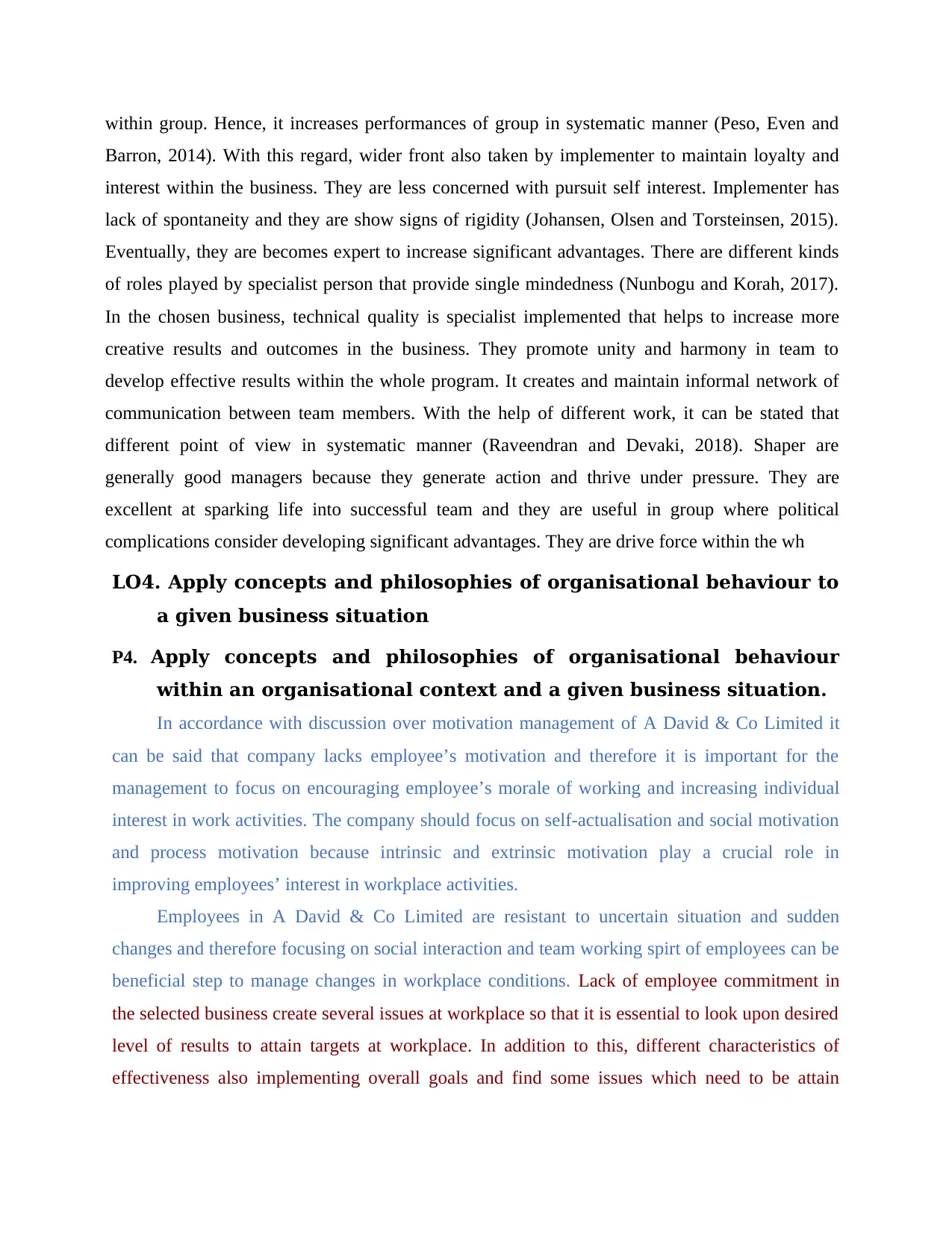
within group. Hence, it increases performances of group in systematic manner (Peso, Even and
Barron, 2014). With this regard, wider front also taken by implementer to maintain loyalty and
interest within the business. They are less concerned with pursuit self interest. Implementer has
lack of spontaneity and they are show signs of rigidity (Johansen, Olsen and Torsteinsen, 2015).
Eventually, they are becomes expert to increase significant advantages. There are different kinds
of roles played by specialist person that provide single mindedness (Nunbogu and Korah, 2017).
In the chosen business, technical quality is specialist implemented that helps to increase more
creative results and outcomes in the business. They promote unity and harmony in team to
develop effective results within the whole program. It creates and maintain informal network of
communication between team members. With the help of different work, it can be stated that
different point of view in systematic manner (Raveendran and Devaki, 2018). Shaper are
generally good managers because they generate action and thrive under pressure. They are
excellent at sparking life into successful team and they are useful in group where political
complications consider developing significant advantages. They are drive force within the wh
LO4. Apply concepts and philosophies of organisational behaviour to
a given business situation
P4. Apply concepts and philosophies of organisational behaviour
within an organisational context and a given business situation.
In accordance with discussion over motivation management of A David & Co Limited it
can be said that company lacks employee’s motivation and therefore it is important for the
management to focus on encouraging employee’s morale of working and increasing individual
interest in work activities. The company should focus on self-actualisation and social motivation
and process motivation because intrinsic and extrinsic motivation play a crucial role in
improving employees’ interest in workplace activities.
Employees in A David & Co Limited are resistant to uncertain situation and sudden
changes and therefore focusing on social interaction and team working spirt of employees can be
beneficial step to manage changes in workplace conditions. Lack of employee commitment in
the selected business create several issues at workplace so that it is essential to look upon desired
level of results to attain targets at workplace. In addition to this, different characteristics of
effectiveness also implementing overall goals and find some issues which need to be attain
Barron, 2014). With this regard, wider front also taken by implementer to maintain loyalty and
interest within the business. They are less concerned with pursuit self interest. Implementer has
lack of spontaneity and they are show signs of rigidity (Johansen, Olsen and Torsteinsen, 2015).
Eventually, they are becomes expert to increase significant advantages. There are different kinds
of roles played by specialist person that provide single mindedness (Nunbogu and Korah, 2017).
In the chosen business, technical quality is specialist implemented that helps to increase more
creative results and outcomes in the business. They promote unity and harmony in team to
develop effective results within the whole program. It creates and maintain informal network of
communication between team members. With the help of different work, it can be stated that
different point of view in systematic manner (Raveendran and Devaki, 2018). Shaper are
generally good managers because they generate action and thrive under pressure. They are
excellent at sparking life into successful team and they are useful in group where political
complications consider developing significant advantages. They are drive force within the wh
LO4. Apply concepts and philosophies of organisational behaviour to
a given business situation
P4. Apply concepts and philosophies of organisational behaviour
within an organisational context and a given business situation.
In accordance with discussion over motivation management of A David & Co Limited it
can be said that company lacks employee’s motivation and therefore it is important for the
management to focus on encouraging employee’s morale of working and increasing individual
interest in work activities. The company should focus on self-actualisation and social motivation
and process motivation because intrinsic and extrinsic motivation play a crucial role in
improving employees’ interest in workplace activities.
Employees in A David & Co Limited are resistant to uncertain situation and sudden
changes and therefore focusing on social interaction and team working spirt of employees can be
beneficial step to manage changes in workplace conditions. Lack of employee commitment in
the selected business create several issues at workplace so that it is essential to look upon desired
level of results to attain targets at workplace. In addition to this, different characteristics of
effectiveness also implementing overall goals and find some issues which need to be attain

appropriate business situation. With the help of Path goal theory, effective leadership style has
been implemented to judge situation and improve significant advantages at workplace.
In order to develop effective performance in organisational behaviour there are different
concept and philosophies successfully develop in appropriate manner. The chosen leadership
style is only acceptable when employs are motivated and satisfied. There are four kinds of
leadership styles identify that are as follows:
Directive leadership style: In this leadership style, leaders knew exactly which must be
done. In this regard, tasks must be performed as per deadlines. It means that leader of A David &
Co limited provides employees with clear guidelines to the processes and tells that expected as
best to carry out tasks. This style of leading will help the leading person in managing
coordination in employees’ activities on the basis of division of roles and responsibilities.
Supportive leadership style: In this kind of leadership leaders pays a lot attention to the
needs and well-being of his employees. Their behaviour also characteristics by being friendly
and empathetic. They treat their employees with respect and supports with necessary. This
management style is useful in situation which employees have personal problems (Greasley and
Wang, 2016). They are temporarily de-motivated in A David & Co limited. This leading
approach will helps A David & Co Limited in managing employees resistant because in this
leading person ill seek for employees participation with the help of which the individuals will eb
able to understand the situation and will lead to cooperation.
Achievement-oriented leadership: In this kind of leadership style, leaders generally sets
challenging goals. They are generally expecting achievement at highest level from employees
and trusts which increase ability to handle it. This approach h can be helps with coordination
with Tuckman team building where A David & Co Limited can focus on grouping employees for
common business goals. This will encourage process motivation where achievement of business
goals will support extrinsic motivation of staff. Approach of leading and managing employee’s
motivation will be beneficial of the company as well as employee’s motivation.
Participative leadership: Participative leadership style, leader deems with very important
to work with employees. Ideas and opinion in decisions can be judging to focus on highly
involvement of decision-making process. It means employees are developing to focus on the
business development with effective leadership (Webb, Morgan and Goddard, 2016). This
approach of leading ill support social motivational needs of staff where leaders of A David & Co
been implemented to judge situation and improve significant advantages at workplace.
In order to develop effective performance in organisational behaviour there are different
concept and philosophies successfully develop in appropriate manner. The chosen leadership
style is only acceptable when employs are motivated and satisfied. There are four kinds of
leadership styles identify that are as follows:
Directive leadership style: In this leadership style, leaders knew exactly which must be
done. In this regard, tasks must be performed as per deadlines. It means that leader of A David &
Co limited provides employees with clear guidelines to the processes and tells that expected as
best to carry out tasks. This style of leading will help the leading person in managing
coordination in employees’ activities on the basis of division of roles and responsibilities.
Supportive leadership style: In this kind of leadership leaders pays a lot attention to the
needs and well-being of his employees. Their behaviour also characteristics by being friendly
and empathetic. They treat their employees with respect and supports with necessary. This
management style is useful in situation which employees have personal problems (Greasley and
Wang, 2016). They are temporarily de-motivated in A David & Co limited. This leading
approach will helps A David & Co Limited in managing employees resistant because in this
leading person ill seek for employees participation with the help of which the individuals will eb
able to understand the situation and will lead to cooperation.
Achievement-oriented leadership: In this kind of leadership style, leaders generally sets
challenging goals. They are generally expecting achievement at highest level from employees
and trusts which increase ability to handle it. This approach h can be helps with coordination
with Tuckman team building where A David & Co Limited can focus on grouping employees for
common business goals. This will encourage process motivation where achievement of business
goals will support extrinsic motivation of staff. Approach of leading and managing employee’s
motivation will be beneficial of the company as well as employee’s motivation.
Participative leadership: Participative leadership style, leader deems with very important
to work with employees. Ideas and opinion in decisions can be judging to focus on highly
involvement of decision-making process. It means employees are developing to focus on the
business development with effective leadership (Webb, Morgan and Goddard, 2016). This
approach of leading ill support social motivational needs of staff where leaders of A David & Co
Secure Best Marks with AI Grader
Need help grading? Try our AI Grader for instant feedback on your assignments.

Limited will ai at involving staff in discussion of every situation. This ill aid in encouraging
employees and managing innovation in working style.
Social capital theory
In order to determines social capital theory, it can be stated that there are several
elements consider which define identified contemporary barriers at workplace of A David
& Co Limited. Therefore, it contains group characteristics, generalised norms,
togetherness, everyday sociability, voluntarism, etc.
Social capital theory
Group characteristics There are several kinds of
group characteristics
considered such as number of
membership, contribution of
money, frequency of
participation, source of group
funding, etc.
Generalised norms Helpful of people,
trustworthiness of people,
fairness of people.
Togetherness Togetherness consist when
people get along with goals
and objectives.
Everyday sociability Everyday sociability assists to
increase more significant
advantages
Neighbourhood Asking with neighbour to take
proper care and helps to set
more direction.
Voluntarism Volunteered people fulfil
expectations with fair
contribution to neighbourhood.
employees and managing innovation in working style.
Social capital theory
In order to determines social capital theory, it can be stated that there are several
elements consider which define identified contemporary barriers at workplace of A David
& Co Limited. Therefore, it contains group characteristics, generalised norms,
togetherness, everyday sociability, voluntarism, etc.
Social capital theory
Group characteristics There are several kinds of
group characteristics
considered such as number of
membership, contribution of
money, frequency of
participation, source of group
funding, etc.
Generalised norms Helpful of people,
trustworthiness of people,
fairness of people.
Togetherness Togetherness consist when
people get along with goals
and objectives.
Everyday sociability Everyday sociability assists to
increase more significant
advantages
Neighbourhood Asking with neighbour to take
proper care and helps to set
more direction.
Voluntarism Volunteered people fulfil
expectations with fair
contribution to neighbourhood.
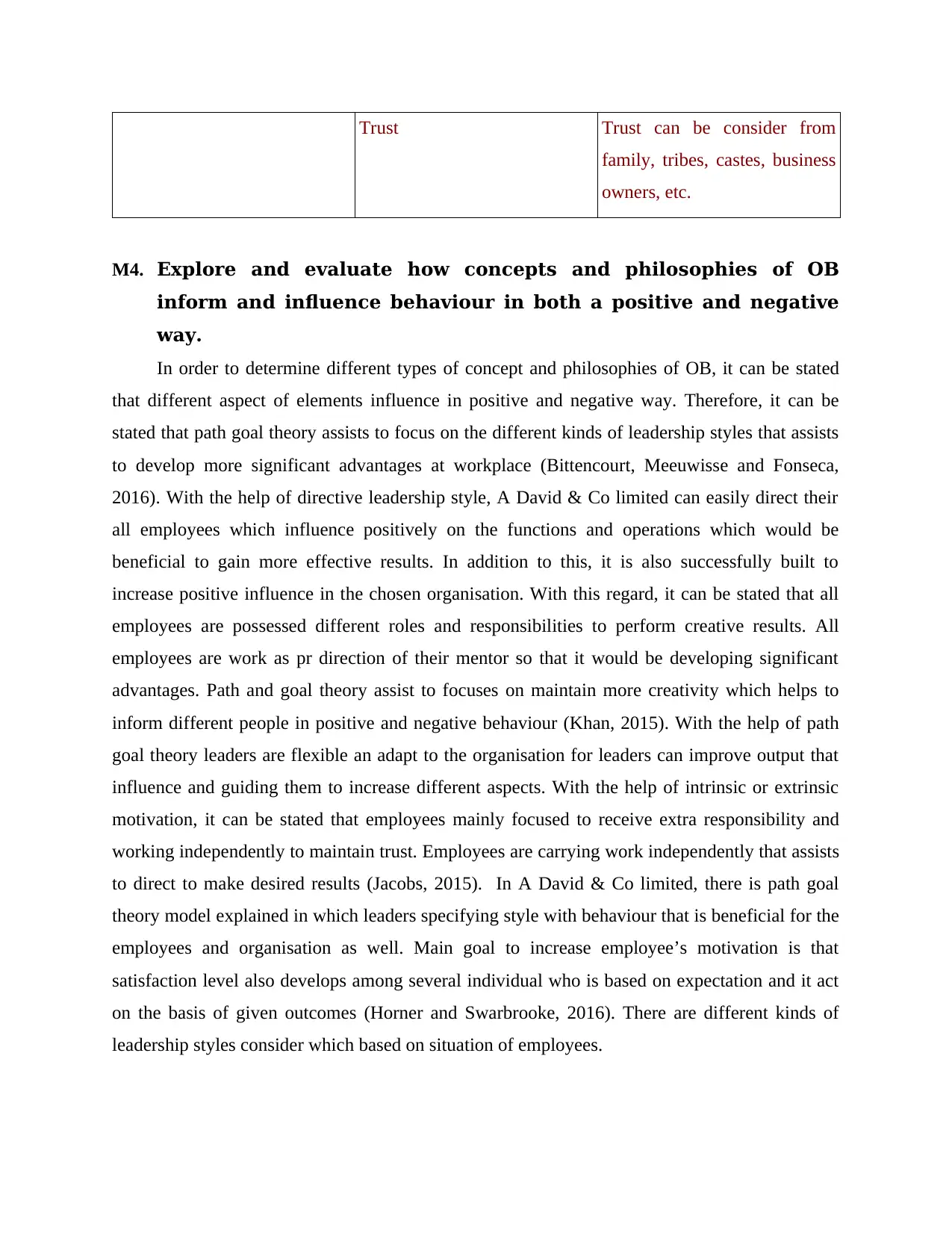
Trust Trust can be consider from
family, tribes, castes, business
owners, etc.
M4. Explore and evaluate how concepts and philosophies of OB
inform and influence behaviour in both a positive and negative
way.
In order to determine different types of concept and philosophies of OB, it can be stated
that different aspect of elements influence in positive and negative way. Therefore, it can be
stated that path goal theory assists to focus on the different kinds of leadership styles that assists
to develop more significant advantages at workplace (Bittencourt, Meeuwisse and Fonseca,
2016). With the help of directive leadership style, A David & Co limited can easily direct their
all employees which influence positively on the functions and operations which would be
beneficial to gain more effective results. In addition to this, it is also successfully built to
increase positive influence in the chosen organisation. With this regard, it can be stated that all
employees are possessed different roles and responsibilities to perform creative results. All
employees are work as pr direction of their mentor so that it would be developing significant
advantages. Path and goal theory assist to focuses on maintain more creativity which helps to
inform different people in positive and negative behaviour (Khan, 2015). With the help of path
goal theory leaders are flexible an adapt to the organisation for leaders can improve output that
influence and guiding them to increase different aspects. With the help of intrinsic or extrinsic
motivation, it can be stated that employees mainly focused to receive extra responsibility and
working independently to maintain trust. Employees are carrying work independently that assists
to direct to make desired results (Jacobs, 2015). In A David & Co limited, there is path goal
theory model explained in which leaders specifying style with behaviour that is beneficial for the
employees and organisation as well. Main goal to increase employee’s motivation is that
satisfaction level also develops among several individual who is based on expectation and it act
on the basis of given outcomes (Horner and Swarbrooke, 2016). There are different kinds of
leadership styles consider which based on situation of employees.
family, tribes, castes, business
owners, etc.
M4. Explore and evaluate how concepts and philosophies of OB
inform and influence behaviour in both a positive and negative
way.
In order to determine different types of concept and philosophies of OB, it can be stated
that different aspect of elements influence in positive and negative way. Therefore, it can be
stated that path goal theory assists to focus on the different kinds of leadership styles that assists
to develop more significant advantages at workplace (Bittencourt, Meeuwisse and Fonseca,
2016). With the help of directive leadership style, A David & Co limited can easily direct their
all employees which influence positively on the functions and operations which would be
beneficial to gain more effective results. In addition to this, it is also successfully built to
increase positive influence in the chosen organisation. With this regard, it can be stated that all
employees are possessed different roles and responsibilities to perform creative results. All
employees are work as pr direction of their mentor so that it would be developing significant
advantages. Path and goal theory assist to focuses on maintain more creativity which helps to
inform different people in positive and negative behaviour (Khan, 2015). With the help of path
goal theory leaders are flexible an adapt to the organisation for leaders can improve output that
influence and guiding them to increase different aspects. With the help of intrinsic or extrinsic
motivation, it can be stated that employees mainly focused to receive extra responsibility and
working independently to maintain trust. Employees are carrying work independently that assists
to direct to make desired results (Jacobs, 2015). In A David & Co limited, there is path goal
theory model explained in which leaders specifying style with behaviour that is beneficial for the
employees and organisation as well. Main goal to increase employee’s motivation is that
satisfaction level also develops among several individual who is based on expectation and it act
on the basis of given outcomes (Horner and Swarbrooke, 2016). There are different kinds of
leadership styles consider which based on situation of employees.

D2. Critically analyse and evaluate the relevance of team development
theories in context of organisational behaviour concepts and
philosophies that influence behaviour in the work place
With the help of tuckman team development theory, it can be stated that different concept
and philosophies must be consider to increase significant advantages at workplace. Furthermore,
it includes 4 stages through A David & Co limited can develop their group performances such as
forming, storming, norming and performing. In this regard, effectiveness will be developing to
maintain effectiveness. It will assist to determine different concepts and philosophies. Moreover,
there are several activities has been promoted which ascertained for team development. It assists
to encourage positive behaviour and performances (Salminen, Vanhala and Heilmann, 2017). On
the other hand, there is different contingencies also followed which would be beneficial to know
about each person participation in the business. Therefore, it targets to accomplish more goals.
Employees get close supervision to management’s styles that are more suited for very
experienced employees who need guidance and to check on regularly (Rickaby, Glass and
McCarthy, 2017). Leaders generally forces which display excellent work achievement and
constant improvement (Oeij, Dhondt and Vroome, 2016). In A David & Co limited employee are
able to work that are fully independently to solve problems with effective management style.
CONCLUSION
From the above report, it can be concluded that organisational behaviour assists to increase
positive results in A David & Co limited. This is because, it helps to conduct study of different
human behaviour which would be beneficial to attain more targets and goals. With the help of
creativity, it can be stated that different types of culture, power and politics create major impact
on the results to develop creativity. In this regard, the chosen business adopted role culture in
which different rules and regulation can be applied to develop more effectiveness. It will
increase positive influence on team and individual in systematic manner. Furthermore, it
summarised about different types of rules and regulations which need to be adopted to increase
positive results at workplace of the organisation. In addition to this, different kinds of team roles
explained that assists to encourage to develop more effective results at workplace.
theories in context of organisational behaviour concepts and
philosophies that influence behaviour in the work place
With the help of tuckman team development theory, it can be stated that different concept
and philosophies must be consider to increase significant advantages at workplace. Furthermore,
it includes 4 stages through A David & Co limited can develop their group performances such as
forming, storming, norming and performing. In this regard, effectiveness will be developing to
maintain effectiveness. It will assist to determine different concepts and philosophies. Moreover,
there are several activities has been promoted which ascertained for team development. It assists
to encourage positive behaviour and performances (Salminen, Vanhala and Heilmann, 2017). On
the other hand, there is different contingencies also followed which would be beneficial to know
about each person participation in the business. Therefore, it targets to accomplish more goals.
Employees get close supervision to management’s styles that are more suited for very
experienced employees who need guidance and to check on regularly (Rickaby, Glass and
McCarthy, 2017). Leaders generally forces which display excellent work achievement and
constant improvement (Oeij, Dhondt and Vroome, 2016). In A David & Co limited employee are
able to work that are fully independently to solve problems with effective management style.
CONCLUSION
From the above report, it can be concluded that organisational behaviour assists to increase
positive results in A David & Co limited. This is because, it helps to conduct study of different
human behaviour which would be beneficial to attain more targets and goals. With the help of
creativity, it can be stated that different types of culture, power and politics create major impact
on the results to develop creativity. In this regard, the chosen business adopted role culture in
which different rules and regulation can be applied to develop more effectiveness. It will
increase positive influence on team and individual in systematic manner. Furthermore, it
summarised about different types of rules and regulations which need to be adopted to increase
positive results at workplace of the organisation. In addition to this, different kinds of team roles
explained that assists to encourage to develop more effective results at workplace.
Paraphrase This Document
Need a fresh take? Get an instant paraphrase of this document with our AI Paraphraser
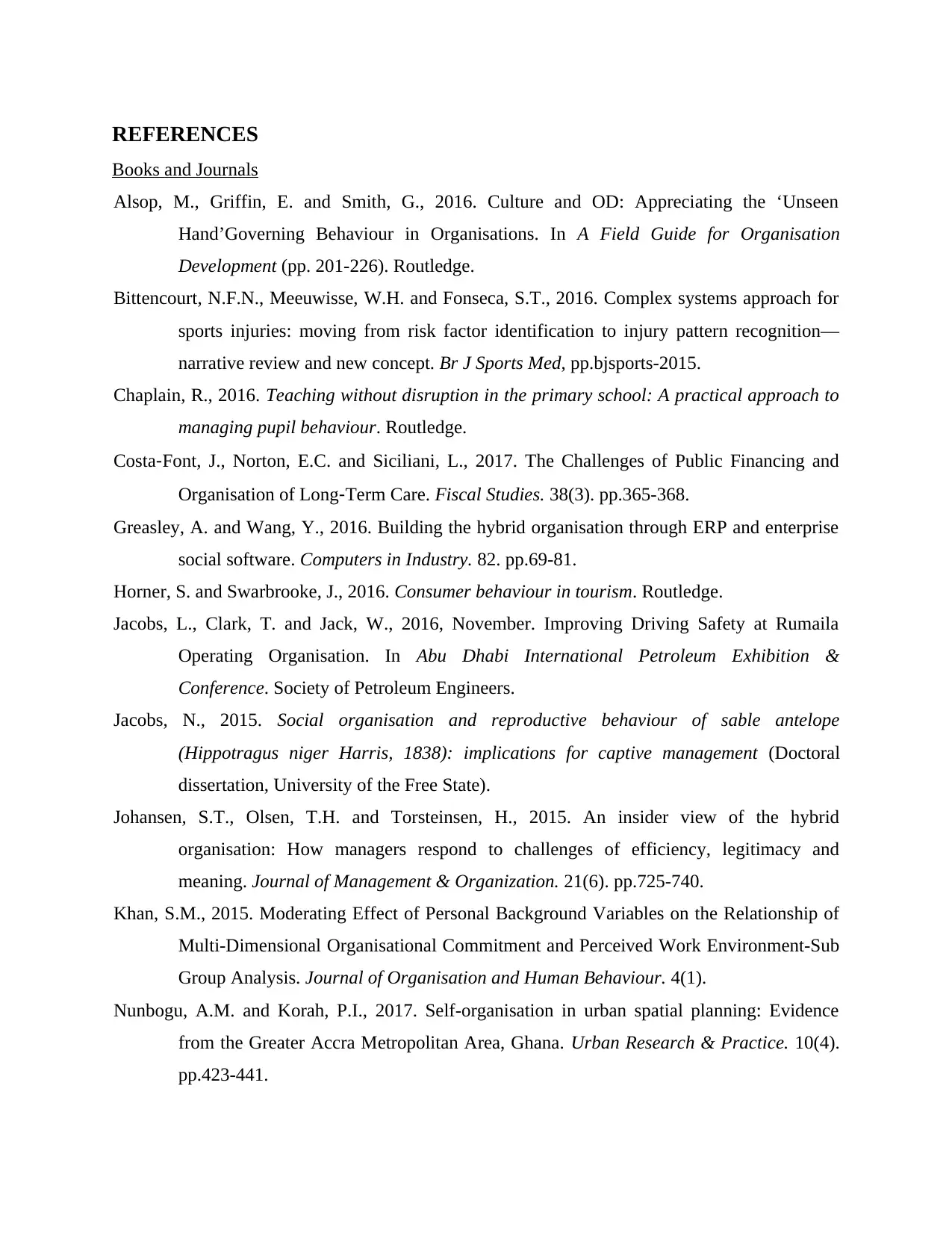
REFERENCES
Books and Journals
Alsop, M., Griffin, E. and Smith, G., 2016. Culture and OD: Appreciating the ‘Unseen
Hand’Governing Behaviour in Organisations. In A Field Guide for Organisation
Development (pp. 201-226). Routledge.
Bittencourt, N.F.N., Meeuwisse, W.H. and Fonseca, S.T., 2016. Complex systems approach for
sports injuries: moving from risk factor identification to injury pattern recognition—
narrative review and new concept. Br J Sports Med, pp.bjsports-2015.
Chaplain, R., 2016. Teaching without disruption in the primary school: A practical approach to
managing pupil behaviour. Routledge.
Costa‐Font, J., Norton, E.C. and Siciliani, L., 2017. The Challenges of Public Financing and
Organisation of Long‐Term Care. Fiscal Studies. 38(3). pp.365-368.
Greasley, A. and Wang, Y., 2016. Building the hybrid organisation through ERP and enterprise
social software. Computers in Industry. 82. pp.69-81.
Horner, S. and Swarbrooke, J., 2016. Consumer behaviour in tourism. Routledge.
Jacobs, L., Clark, T. and Jack, W., 2016, November. Improving Driving Safety at Rumaila
Operating Organisation. In Abu Dhabi International Petroleum Exhibition &
Conference. Society of Petroleum Engineers.
Jacobs, N., 2015. Social organisation and reproductive behaviour of sable antelope
(Hippotragus niger Harris, 1838): implications for captive management (Doctoral
dissertation, University of the Free State).
Johansen, S.T., Olsen, T.H. and Torsteinsen, H., 2015. An insider view of the hybrid
organisation: How managers respond to challenges of efficiency, legitimacy and
meaning. Journal of Management & Organization. 21(6). pp.725-740.
Khan, S.M., 2015. Moderating Effect of Personal Background Variables on the Relationship of
Multi-Dimensional Organisational Commitment and Perceived Work Environment-Sub
Group Analysis. Journal of Organisation and Human Behaviour. 4(1).
Nunbogu, A.M. and Korah, P.I., 2017. Self-organisation in urban spatial planning: Evidence
from the Greater Accra Metropolitan Area, Ghana. Urban Research & Practice. 10(4).
pp.423-441.
Books and Journals
Alsop, M., Griffin, E. and Smith, G., 2016. Culture and OD: Appreciating the ‘Unseen
Hand’Governing Behaviour in Organisations. In A Field Guide for Organisation
Development (pp. 201-226). Routledge.
Bittencourt, N.F.N., Meeuwisse, W.H. and Fonseca, S.T., 2016. Complex systems approach for
sports injuries: moving from risk factor identification to injury pattern recognition—
narrative review and new concept. Br J Sports Med, pp.bjsports-2015.
Chaplain, R., 2016. Teaching without disruption in the primary school: A practical approach to
managing pupil behaviour. Routledge.
Costa‐Font, J., Norton, E.C. and Siciliani, L., 2017. The Challenges of Public Financing and
Organisation of Long‐Term Care. Fiscal Studies. 38(3). pp.365-368.
Greasley, A. and Wang, Y., 2016. Building the hybrid organisation through ERP and enterprise
social software. Computers in Industry. 82. pp.69-81.
Horner, S. and Swarbrooke, J., 2016. Consumer behaviour in tourism. Routledge.
Jacobs, L., Clark, T. and Jack, W., 2016, November. Improving Driving Safety at Rumaila
Operating Organisation. In Abu Dhabi International Petroleum Exhibition &
Conference. Society of Petroleum Engineers.
Jacobs, N., 2015. Social organisation and reproductive behaviour of sable antelope
(Hippotragus niger Harris, 1838): implications for captive management (Doctoral
dissertation, University of the Free State).
Johansen, S.T., Olsen, T.H. and Torsteinsen, H., 2015. An insider view of the hybrid
organisation: How managers respond to challenges of efficiency, legitimacy and
meaning. Journal of Management & Organization. 21(6). pp.725-740.
Khan, S.M., 2015. Moderating Effect of Personal Background Variables on the Relationship of
Multi-Dimensional Organisational Commitment and Perceived Work Environment-Sub
Group Analysis. Journal of Organisation and Human Behaviour. 4(1).
Nunbogu, A.M. and Korah, P.I., 2017. Self-organisation in urban spatial planning: Evidence
from the Greater Accra Metropolitan Area, Ghana. Urban Research & Practice. 10(4).
pp.423-441.
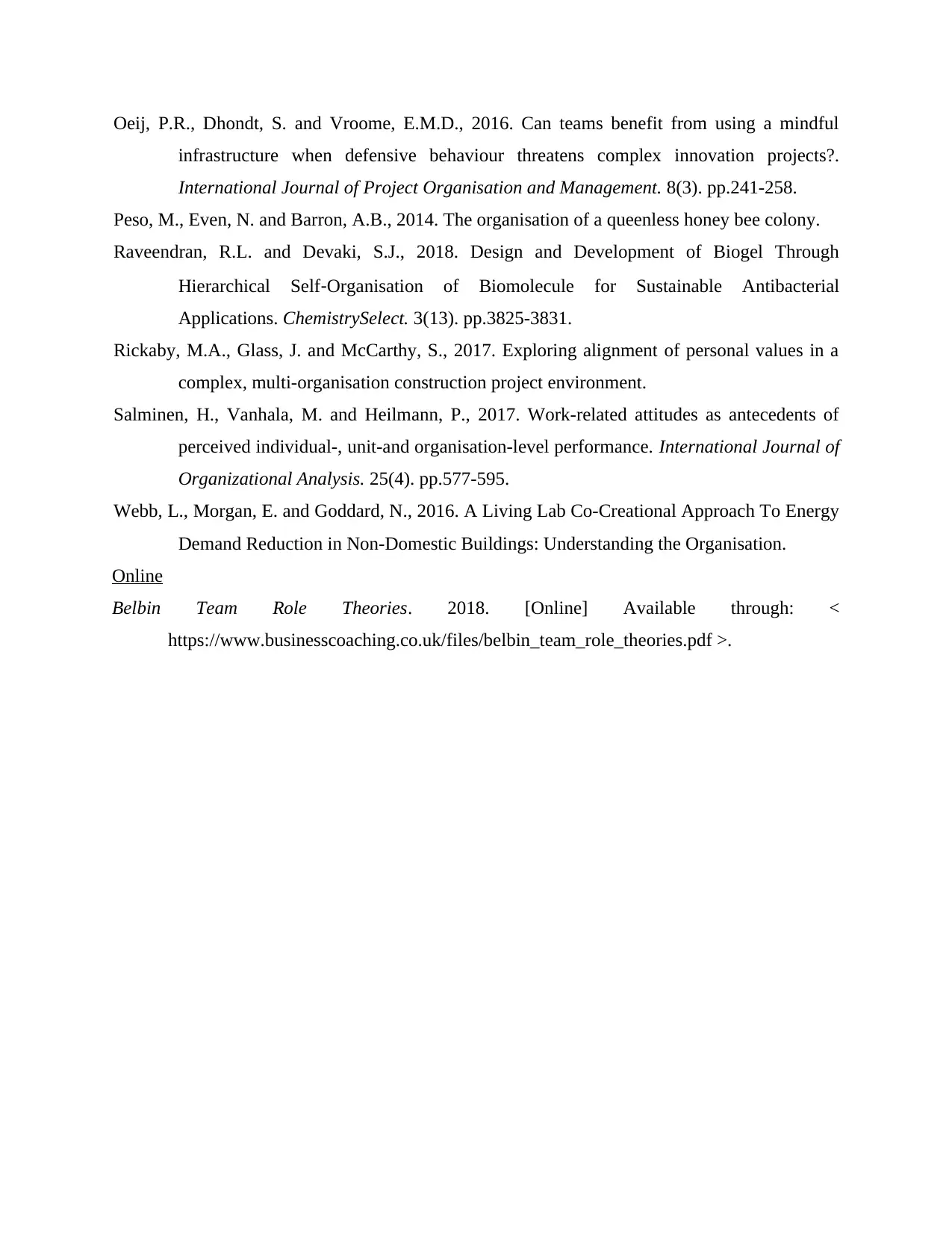
Oeij, P.R., Dhondt, S. and Vroome, E.M.D., 2016. Can teams benefit from using a mindful
infrastructure when defensive behaviour threatens complex innovation projects?.
International Journal of Project Organisation and Management. 8(3). pp.241-258.
Peso, M., Even, N. and Barron, A.B., 2014. The organisation of a queenless honey bee colony.
Raveendran, R.L. and Devaki, S.J., 2018. Design and Development of Biogel Through
Hierarchical Self‐Organisation of Biomolecule for Sustainable Antibacterial
Applications. ChemistrySelect. 3(13). pp.3825-3831.
Rickaby, M.A., Glass, J. and McCarthy, S., 2017. Exploring alignment of personal values in a
complex, multi-organisation construction project environment.
Salminen, H., Vanhala, M. and Heilmann, P., 2017. Work-related attitudes as antecedents of
perceived individual-, unit-and organisation-level performance. International Journal of
Organizational Analysis. 25(4). pp.577-595.
Webb, L., Morgan, E. and Goddard, N., 2016. A Living Lab Co-Creational Approach To Energy
Demand Reduction in Non-Domestic Buildings: Understanding the Organisation.
Online
Belbin Team Role Theories. 2018. [Online] Available through: <
https://www.businesscoaching.co.uk/files/belbin_team_role_theories.pdf >.
infrastructure when defensive behaviour threatens complex innovation projects?.
International Journal of Project Organisation and Management. 8(3). pp.241-258.
Peso, M., Even, N. and Barron, A.B., 2014. The organisation of a queenless honey bee colony.
Raveendran, R.L. and Devaki, S.J., 2018. Design and Development of Biogel Through
Hierarchical Self‐Organisation of Biomolecule for Sustainable Antibacterial
Applications. ChemistrySelect. 3(13). pp.3825-3831.
Rickaby, M.A., Glass, J. and McCarthy, S., 2017. Exploring alignment of personal values in a
complex, multi-organisation construction project environment.
Salminen, H., Vanhala, M. and Heilmann, P., 2017. Work-related attitudes as antecedents of
perceived individual-, unit-and organisation-level performance. International Journal of
Organizational Analysis. 25(4). pp.577-595.
Webb, L., Morgan, E. and Goddard, N., 2016. A Living Lab Co-Creational Approach To Energy
Demand Reduction in Non-Domestic Buildings: Understanding the Organisation.
Online
Belbin Team Role Theories. 2018. [Online] Available through: <
https://www.businesscoaching.co.uk/files/belbin_team_role_theories.pdf >.
1 out of 21
Related Documents
Your All-in-One AI-Powered Toolkit for Academic Success.
+13062052269
info@desklib.com
Available 24*7 on WhatsApp / Email
![[object Object]](/_next/static/media/star-bottom.7253800d.svg)
Unlock your academic potential
© 2024 | Zucol Services PVT LTD | All rights reserved.





